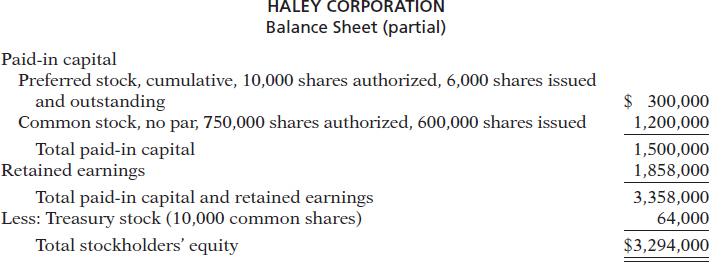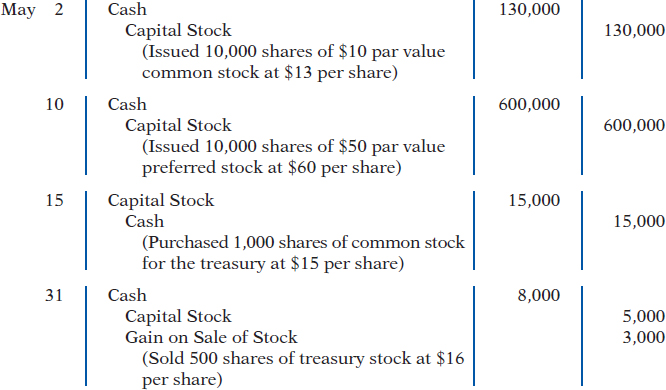11  Corporations: Organization, Stock Transactions, Dividends, and Retained Earnings
Corporations: Organization, Stock Transactions, Dividends, and Retained Earnings
Feature Story What's Cooking?
![]()
What major U.S. corporation got its start 41 years ago with a waffle iron? Hint: It doesn't sell food. Another hint: Swoosh. Another hint: “Just do it.” That's right, Nike. In 1971, Nike co-founder Bill Bowerman put a piece of rubber into a kitchen waffle iron, and the trademark waffle sole was born. It seems fair to say that at Nike, “They don't make 'em like they used to.”
Nike was co-founded by Bowerman and Phil Knight, a member of Bowerman's University of Oregon track team. Each began in the shoe business independently during the early 1960s. Bowerman got his start by making hand-crafted running shoes for his University of Oregon track team. Knight, after completing graduate school, started a small business importing low-cost, high-quality shoes from Japan. In 1964, the two joined forces, each contributing $500, and formed Blue Ribbon Sports, a partnership that marketed Japanese shoes. It wasn't until 1971 that the company began manufacturing its own line of shoes. With the new shoes came a new corporate name–Nike–the Greek goddess of victory. It is hard to imagine that the company that now boasts a stable full of world-class athletes as promoters at one time had part-time employees selling shoes out of car trunks at track meets. Nike has achieved its success through relentless innovation combined with unbridled promotion.
By 1980, Nike was sufficiently established and issued its first stock to the public. That same year, it created a stock ownership program for its employees, allowing them to share in the company's success. Since then, Nike has enjoyed phenomenal growth, with 2012 sales reaching $24.1 billion and total dividends paid of $619 million.
Nike is not alone in its quest for the top of the sport shoe world. Reebok used to be Nike's arch rival (get it? “arch”), but then Reebok was acquired by the German company adidas. Now adidas pushes Nike every step of the way.
![]()
 Scan Learning Objectives
Scan Learning Objectives Read Feature Story
Read Feature Story Read Preview
Read Preview Read text and answer DO IT! p. 551
Read text and answer DO IT! p. 551
 p. 553
p. 553  p. 556
p. 556  p. 560
p. 560  p. 565
p. 565 p. 569
p. 569  p. 572
p. 572  p. 575
p. 575 Work Comprehensive DO IT! p. 575
Work Comprehensive DO IT! p. 575 Review Summary of Learning Objectives
Review Summary of Learning Objectives Answer Self-Test Questions
Answer Self-Test Questions Complete Assignments
Complete Assignments Go to WileyPLUS for practice and tutorials
Go to WileyPLUS for practice and tutorials Read A Look at IFRS p. 600
Read A Look at IFRS p. 600
Learning Objectives ![]()
After studying this chapter, you should be able to:
[1] Identify the major characteristics of a corporation.
[2] Record the issuance of common stock.
[3] Explain the accounting for treasury stock.
[4] Differentiate preferred stock from common stock.
[5] Prepare the entries for cash dividends and stock dividends.
[6] Identify the items reported in a retained earnings statement.
[7] Prepare and analyze a comprehensive stockholders' equity section.
The shoe market is fickle, with new styles becoming popular almost daily and vast international markets still lying untapped. Whether one of these two giants does eventually take control of the pedi-planet remains to be seen. Meanwhile, the shareholders sit anxiously in the stands as this Olympic-size drama unfolds.
Preview of Chapter 11
![]()
Corporations like Nike and adidas have substantial resources at their disposal. In fact, the corporation is the dominant form of business organization in the United States in terms of sales, earnings, and number of employees. All of the 500 largest companies in the United States are corporations. In this chapter, we will explain the essential features of a corporation and the accounting for a corporation's capital stock transactions.
The content and organization of Chapter 11 are as follows.

![]() 1
1
Identify the major characteristics of a corporation.
The Corporate Form of Organization
In 1819, Chief Justice John Marshall defined a corporation as “an artificial being, invisible, intangible, and existing only in contemplation of law.” This definition is the foundation for the prevailing legal interpretation that a corporation is an entity separate and distinct from its owners.
A corporation is created by law, and its continued existence depends upon the statutes of the state in which it is incorporated. As a legal entity, a corporation has most of the rights and privileges of a person. The major exceptions relate to privileges that only a living person can exercise, such as the right to vote or to hold public office. A corporation is subject to the same duties and responsibilities as a person. For example, it must abide by the laws, and it must pay taxes.
Two common ways to classify corporations are by purpose and by ownership. A corporation may be organized for the purpose of making a profit, or it may be not-for-profit. For-profit corporations include such well-known companies as McDonald's, Nike, PepsiCo, and Google. Not-for-profit corporations are organized for charitable, medical, or educational purposes. Examples are the Salvation Army and the American Cancer Society.
Classification by ownership differentiates publicly held and privately held corporations. A publicly held corporation may have thousands of stockholders. Its stock is regularly traded on a national securities exchange such as the New York Stock Exchange. Examples are IBM, Caterpillar, and General Electric.
Alternative Terminology
Privately held corporations are also referred to as closely held corporations.
In contrast, a privately held corporation usually has only a few stockholders, and does not offer its stock for sale to the general public. Privately held companies are generally much smaller than publicly held companies, although some notable exceptions exist. Cargill Inc., a private corporation that trades in grain and other commodities, is one of the largest companies in the United States.
Characteristics of a Corporation
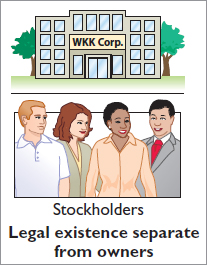
In 1964, when Nike's founders Phil Knight and Bill Bowerman were just getting started in the running shoe business, they formed their original organization as a partnership. In 1968, they reorganized the company as a corporation. A number of characteristics distinguish corporations from proprietorships and partnerships. We explain the most important of these characteristics below.
SEPARATE LEGAL EXISTENCE
As an entity separate and distinct from its owners, the corporation acts under its own name rather than in the name of its stockholders. Nike may buy, own, and sell property. It may borrow money, and may enter into legally binding contracts in its own name. It may also sue or be sued, and it pays its own taxes.
In a partnership, the acts of the owners (partners) bind the partnership. In contrast, the acts of its owners (stockholders) do not bind the corporation unless such owners are agents of the corporation. For example, if you owned shares of Nike stock, you would not have the right to purchase inventory for the company unless you were designated as an agent of the corporation.

LIMITED LIABILITY OF STOCKHOLDERS
Since a corporation is a separate legal entity, creditors have recourse only to corporate assets to satisfy their claims. The liability of stockholders is normally limited to their investment in the corporation. Creditors have no legal claim on the personal assets of the owners unless fraud has occurred. Even in the event of bankruptcy, stockholders' losses are generally limited to their capital investment in the corporation.
TRANSFERABLE OWNERSHIP RIGHTS
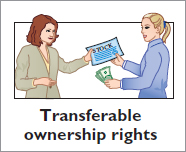
Shares of capital stock give ownership in a corporation. These shares are transferable units. Stockholders may dispose of part or all of their interest in a corporation simply by selling their stock. The transfer of an ownership interest in a partnership requires the consent of each owner. In contrast, the transfer of stock is entirely at the discretion of the stockholder. It does not require the approval of either the corporation or other stockholders.
The transfer of ownership rights between stockholders normally has no effect on the daily operating activities of the corporation. Nor does it affect the corporation's assets, liabilities, and total ownership equity. The transfer of these ownership rights is a transaction between individual owners. The company does not participate in the transfer of these ownership rights after the original sale of the capital stock.
ABILITY TO ACQUIRE CAPITAL
It is relatively easy for a corporation to obtain capital through the issuance of stock. Buying stock in a corporation is often attractive to an investor because a stockholder has limited liability and shares of stock are readily transferable. Also, numerous individuals can become stockholders by investing relatively small amounts of money.
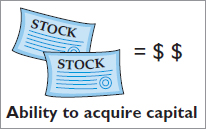
CONTINUOUS LIFE
The life of a corporation is stated in its charter. The life may be perpetual, or it may be limited to a specific number of years. If it is limited, the company can extend the life through renewal of the charter. Since a corporation is a separate legal entity, its continuance as a going concern is not affected by the withdrawal, death, or incapacity of a stockholder, employee, or officer. As a result, a successful company can have a continuous and perpetual life.
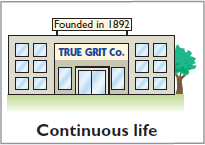
CORPORATION MANAGEMENT
Stockholders legally own the corporation. However, they manage the corporation indirectly through a board of directors they elect. Philip Knight is the chairman of the board for Nike. The board, in turn, formulates the operating policies for the company. The board also selects officers, such as a president and one or more vice presidents, to execute policy and to perform daily management functions. As a result of the Sarbanes-Oxley Act, the board is now required to monitor management's actions more closely. Many feel that the failures of Enron, WorldCom, and more recently MF Global could have been avoided by more diligent boards.
Illustration 11-1 (page 546) presents a typical organization chart showing the delegation of responsibility. The chief executive officer (CEO) has overall responsibility for managing the business. As the organization chart shows, the CEO delegates responsibility to other officers. The chief accounting officer is the controller. The controller's responsibilities include (1) maintaining the accounting records, (2) maintaining an adequate system of internal control, and (3) preparing financial statements, tax returns, and internal reports. The treasurer has custody of the corporation's funds and is responsible for maintaining the company's cash position.
Ethics Note ![]()
Managers who are not owners are often compensated based on the performance of the firm. They thus may be tempted to exaggerate firm performance by inflating income figures.
The organizational structure of a corporation enables a company to hire professional managers to run the business. On the other hand, the separation of ownership and management often reduces an owner's ability to actively manage the company.
Illustration 11-1
Corporation organization chart
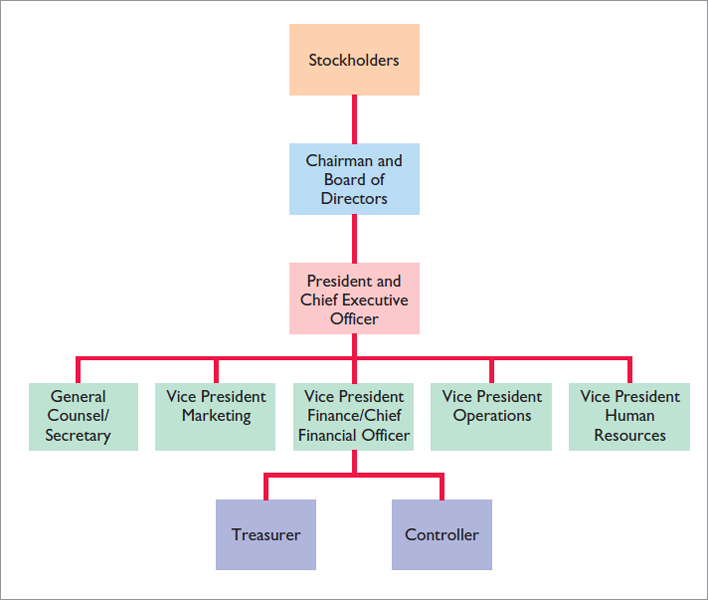
GOVERNMENT REGULATIONS

A corporation is subject to numerous state and federal regulations. For example, state laws usually prescribe the requirements for issuing stock, the distributions of earnings permitted to stockholders, and the acceptable methods for buying back and retiring stock. Federal securities laws govern the sale of capital stock to the general public. Also, most publicly held corporations are required to make extensive disclosure of their financial affairs to the Securities and Exchange Commission (SEC) through quarterly and annual reports. In addition, when a corporation lists its stock on organized securities exchanges, it must comply with the reporting requirements of these exchanges. Government regulations are designed to protect the owners of the corporation.
ADDITIONAL TAXES

Owners of proprietorships and partnerships report their share of earnings on their personal income tax returns. The individual owner then pays taxes on this amount. Corporations, on the other hand, must pay federal and state income taxes as a separate legal entity. These taxes can be substantial. They can amount to as much as 40% of taxable income.
In addition, stockholders must pay taxes on cash dividends (pro rata distributions of net income). Thus, many argue that the government taxes corporate income twice (double taxation)—once at the corporate level and again at the individual level.
In summary, Illustration 11-2 shows the advantages and disadvantages of a corporation compared to a proprietorship and a partnership.
Forming a Corporation
A corporation is formed by grant of a state charter. The charter is a document that describes the name and purpose of the corporation, the types and number of shares of stock that are authorized to be issued, the names of the individuals that formed the company, and the number of shares that these individuals agreed to purchase. Regardless of the number of states in which a corporation has operating divisions, it is incorporated in only one state.
Illustration 11-2
Advantages and disadvantages of a corporation

Alternative Terminology
The charter is often referred to as the articles of incorporation.
It is to the company's advantage to incorporate in a state whose laws are favorable to the corporate form of business organization. For example, although General Motors has its headquarters in Michigan, it is incorporated in New Jersey. In fact, more and more corporations have been incorporating in states with rules that favor existing management. For example, Gulf Oil changed its state of incorporation to Delaware to thwart possible unfriendly takeovers. There, certain defensive tactics against takeovers can be approved by the board of directors alone, without a vote by shareholders.
Upon receipt of its charter from the state of incorporation, the corporation establishes by-laws. The by-laws establish the internal rules and procedures for conducting the affairs of the corporation. Corporations engaged in interstate commerce must also obtain a license from each state in which they do business. The license subjects the corporation's operating activities to the general corporation laws of the state.
Costs incurred in the formation of a corporation are called organization costs. These costs include legal and state fees, and promotional expenditures involved in the organization of the business. Corporations expense organization costs as incurred. Determining the amount and timing of future benefits is so difficult that it is standard procedure to take a conservative approach of expensing these costs immediately.
ACCOUNTING ACROSS THE ORGANIZATION 
A Thousand Millionaires!

Traveling to space or embarking on an expedition to excavate lost Mayan ruins are normally the stuff of adventure novels. But for employees of Facebook, these and other lavish dreams moved closer to reality when the world's No. 1 online social network went public through an initial public offering (IPO) that may have created at least a thousand millionaires. The IPO was the largest in Internet history, valuing Facebook at over $104 billion.
With all these riches to be had, why did Mark Zuckerberg, the founder of Facebook, delay taking his company public? Consider that the main motivation for issuing shares to the public is to raise money so you can grow your business. However, unlike a manufacturer or even an online retailer, Facebook doesn't need major physical resources, it doesn't have inventory, and it doesn't really need much money for marketing. So in the past, the company hasn't had much need for additional cash beyond what it was already generating on its own. Finally, as head of a closely held, nonpublic company, Zuckerberg was subject to far fewer regulations than a public company.
Source: “Status Update: I'm Rich! Facebook Flotation to Create 1,000 Millionaires Among Company's Rank and File,” Daily Mail Reporter (February 1, 2012).
 Why did Mark Zuckerberg, the CEO and founder of Facebook, delay taking his company's shares public through an initial public offering (IPO)? (See page 600.)
Why did Mark Zuckerberg, the CEO and founder of Facebook, delay taking his company's shares public through an initial public offering (IPO)? (See page 600.)
Stockholder Rights
When chartered, the corporation may begin selling shares of stock. When a corporation has only one class of stock, it is common stock. Each share of common stock gives the stockholder the ownership rights pictured in Illustration 11-3. The articles of incorporation or the by-laws state the ownership rights of a share of stock.
Illustration 11-3
Ownership rights of stockholders

Proof of stock ownership is evidenced by a form known as a stock certificate. As Illustration 11-4 shows, the face of the certificate shows the name of the corporation, the stockholder's name, the class and special features of the stock, the number of shares owned, and the signatures of authorized corporate officials. Prenumbered certificates facilitate accountability. They may be issued for any quantity of shares.
Stock Issue Considerations
Although Nike incorporated in 1968, it did not sell stock to the public until 1980. At that time, Nike evidently decided it would benefit from the infusion of cash that a public sale would bring. When a corporation decides to issue stock, it must resolve a number of basic questions: How many shares should it authorize for sale? How should it issue the stock? What value should the corporation assign to the stock? We address these questions in the following sections.
Illustration 11-4
A stock certificate

AUTHORIZED STOCK
The charter indicates the amount of stock that a corporation is authorized to sell. The total amount of authorized stock at the time of incorporation normally anticipates both initial and subsequent capital needs. As a result, the number of shares authorized generally exceeds the number initially sold. If it sells all authorized stock, a corporation must obtain consent of the state to amend its charter before it can issue additional shares.
The authorization of capital stock does not result in a formal accounting entry. The reason is that the event has no immediate effect on either corporate assets or stockholders' equity. However, the number of authorized shares is often reported in the stockholders' equity section. It is then simple to determine the number of unissued shares that the corporation can issue without amending the charter: subtract the total shares issued from the total authorized. For example, if Advanced Micro was authorized to sell 100,000 shares of common stock and issued 80,000 shares, 20,000 shares would remain unissued.
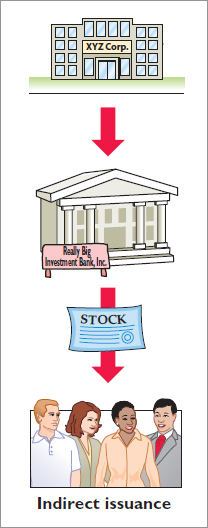
ISSUANCE OF STOCK
A corporation can issue common stock directly to investors. Alternatively, it can issue the stock indirectly through an investment banking firm that specializes in bringing securities to the attention of prospective investors. Direct issue is typical in closely held companies. Indirect issue is customary for a publicly held corporation.
In an indirect issue, the investment banking firm may agree to underwrite the entire stock issue. In this arrangement, the investment banker buys the stock from the corporation at a stipulated price and resells the shares to investors. The corporation thus avoids any risk of being unable to sell the shares. Also, it obtains immediate use of the cash received from the underwriter. The investment banking firm, in turn, assumes the risk of reselling the shares, in return for an underwriting fee.2 For example, Google (the world's number-one Internet search engine) used underwriters when it issued a highly successful initial public offering, raising $1.67 billion. The underwriters charged a 3% underwriting fee (approximately $50 million) on Google's stock offering.
How does a corporation set the price for a new issue of stock? Among the factors to be considered are (1) the company's anticipated future earnings, (2) its expected dividend rate per share, (3) its current financial position, (4) the current state of the economy, and (5) the current state of the securities market. The calculation can be complex and is properly the subject of a finance course.
MARKET PRICE OF STOCK
The stock of publicly held companies is traded on organized exchanges. The interaction between buyers and sellers determines the prices per share. In general, the prices set by the marketplace tend to follow the trend of a company's earnings and dividends. But, factors beyond a company's control, such as an oil embargo, changes in interest rates, and the outcome of a presidential election, may cause day-to-day fluctuations in market prices.
The trading of capital stock on securities exchanges involves the transfer of already issued shares from an existing stockholder to another investor. These transactions have no impact on a corporation's stockholders' equity.
INVESTOR INSIGHT 
How to Read Stock Quotes

Organized exchanges trade the stock of publicly held companies at dollar prices per share established by the interaction between buyers and sellers. For each listed security, the financial press reports the high and low prices of the stock during the year, the total volume of stock traded on a given day, the high and low prices for the day, and the closing market price, with the net change for the day. Nike is listed on the New York Stock Exchange. Here is a listing for Nike:

These numbers indicate the following. The high and low market prices for the last 52 weeks have been $78.55 and $48.76. The trading volume for the day was 5,375,651 shares. The high, low, and closing prices for that date were $72.44, $69.78, and $70.61, respectively. The net change for the day was a decrease of $1.69 per share.
 For stocks traded on organized exchanges, how are the dollar prices per share established? What factors might influence the price of shares in the marketplace? (See page 600.)
For stocks traded on organized exchanges, how are the dollar prices per share established? What factors might influence the price of shares in the marketplace? (See page 600.)
PAR AND NO-PAR VALUE STOCKS
Par value stock is capital stock to which the charter has assigned a value per share. Years ago, par value determined the legal capital per share that a company must retain in the business for the protection of corporate creditors. That amount was not available for withdrawal by stockholders. Thus, in the past, most states required the corporation to sell its shares at par or above.
However, par value was often immaterial relative to the value of the company's stock—even at the time of issue. Thus, its usefulness as a protective device to creditors was questionable. For example, Loews Corporation's par value is $0.01 per share, yet a new issue in 2013 would have sold at a market price in the $46 per share range. Thus, par has no relationship with market price. In the vast majority of cases, it is an immaterial amount. As a consequence, today many states do not require a par value. Instead, they use other means to protect creditors.
No-par value stock is capital stock to which the charter has not assigned a value. No-par value stock is fairly common today. For example, Nike and Procter & Gamble both have no-par stock. In many states, the board of directors assigns a stated value to no-par shares.
> DO IT!
Corporate Organization
Indicate whether each of the following statements is true or false. If false, indicate how to correct the statement.
- _____ 1. Similar to partners in a partnership, stockholders of a corporation have unlimited liability.
- _____ 2. It is relatively easy for a corporation to obtain capital through the issuance of stock.
- _____ 3. The separation of ownership and management is an advantage of the corporate form of business.
- _____ 4. The journal entry to record the authorization of capital stock includes a credit to the appropriate capital stock account.
- _____ 5. All states require a par value per share for capital stock.
Action Plan
![]() Review the characteristics of a corporation and understand which are advantages and which are disadvantages.
Review the characteristics of a corporation and understand which are advantages and which are disadvantages.
![]() Understand that corporations raise capital through the issuance of stock, which can be par or no-par.
Understand that corporations raise capital through the issuance of stock, which can be par or no-par.
Solution
- False. The liability of stockholders is normally limited to their investment in the corporation.
- True.
- False. The separation of ownership and management is a disadvantage of the corporate form of business.
- False. The authorization of capital stock does not result in a formal accounting entry.
- False. Many states do not require a par value.
Related exercise material: BE11-1, E11-1, E11-2, and DO IT! 11-1.
![]()
Corporate Capital
Owners' equity is identified by various names: stockholders' equity, shareholders' equity, or corporate capital. The stockholders' equity section of a corporation's balance sheet consists of two parts: (1) paid-in (contributed) capital and (2) retained earnings (earned capital).
The distinction between paid-in capital and retained earnings is important from both a legal and a financial point of view. Legally, corporations can make distributions of earnings (declare dividends) out of retained earnings in all states. However, in many states they cannot declare dividends out of paid-in capital. Management, stockholders, and others often look to retained earnings for the continued existence and growth of the corporation.
PAID-IN CAPITAL
Paid-in capital is the total amount of cash and other assets paid in to the corporation by stockholders in exchange for capital stock. As noted earlier, when a corporation has only one class of stock, it is common stock.
RETAINED EARNINGS
Retained earnings is net income that a corporation retains for future use. Net income is recorded in Retained Earnings by a closing entry that debits Income Summary and credits Retained Earnings. For example, assuming that net income for Delta Robotics in its first year of operations is $130,000, the closing entry is:


If Delta Robotics has a balance of $800,000 in common stock at the end of its first year, its stockholders' equity section is as follows.
Illustration 11-5
Stockholders' equity section

Illustration 11-6 compares the owners' equity (stockholders' equity) accounts reported on a balance sheet for a proprietorship and a corporation.
Illustration 11-6
Comparison of owners' equity accounts
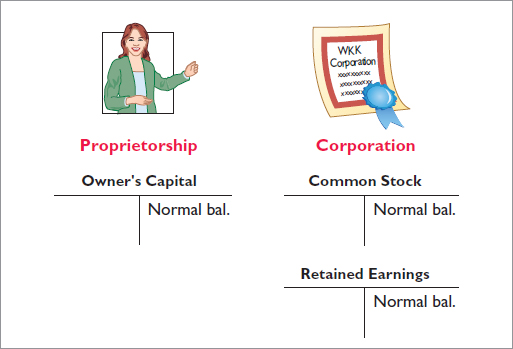
PEOPLE, PLANET, AND PROFIT INSIGHT ![]()
The Impact of Corporate Social Responsibility

A recent survey conducted by Institutional Shareholder Services, a proxy advisory firm, shows that 83% of investors now believe environmental and social factors can significantly impact shareholder value over the long term. This belief is clearly visible in the rising level of support for shareholder proposals requesting action related to social and environmental issues.
The following table shows that the number of corporate social responsibility (CSR)-related shareholder proposals rose from 150 in 2000 to 191 in 2010. Moreover, those proposals received average voting support of 18.4% of votes cast versus just 7.5% a decade earlier.
Trends in Shareholder Proposals on Corporate Responsibility

Source: Investor Responsibility Research Center, Ernst & Young, Seven Questions CEOs and Boards Should Ask About: “Triple Bottom Line” Reporting.
 Why are CSR-related shareholder proposals increasing? (See page 600.)
Why are CSR-related shareholder proposals increasing? (See page 600.)
> DO IT!
Corporate Capital
At the end of its first year of operation, Doral Corporation has $750,000 of common stock and net income of $122,000. Prepare (a) the closing entry for net income and (b) the stockholders' equity section at year-end.
Action Plan
![]() Record net income in Retained Earnings by a closing entry in which Income Summary is debited and Retained Earnings is credited.
Record net income in Retained Earnings by a closing entry in which Income Summary is debited and Retained Earnings is credited.
![]() In the stockholders' equity section, show (1) paid-in capital and (2) retained earnings.
In the stockholders' equity section, show (1) paid-in capital and (2) retained earnings.
Solution

Related exercise material: DO IT! 11-2.
![]()
Accounting for Stock Transactions
![]() 2
2
Record the issuance of common stock.
Accounting for Common Stock
Let's now look at how to account for issues of common stock. The primary objectives in accounting for the issuance of common stock are (1) to identify the specific sources of paid-in capital, and (2) to maintain the distinction between paid-in capital and retained earnings. The issuance of common stock affects only paid-in capital accounts.
ISSUING PAR VALUE COMMON STOCK FOR CASH
As discussed earlier, par value does not indicate a stock's market price. Therefore, the cash proceeds from issuing par value stock may be equal to, greater than, or less than par value. When the company records issuance of common stock for cash, it credits the par value of the shares to Common Stock. It also records in a separate paid-in capital account the portion of the proceeds that is above or below par value.
To illustrate, assume that Hydro-Slide, Inc. issues 1,000 shares of $1 par value common stock at par for cash. The entry to record this transaction is:


Now assume that Hydro-Slide issues an additional 1,000 shares of the $1 par value common stock for cash at $5 per share. The amount received above the par value, in this case $4 ($5 − $1), is credited to Paid-in Capital in Excess of Par—Common Stock. The entry is:

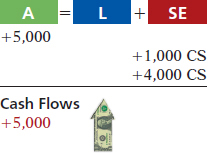
The total paid-in capital from these two transactions is $6,000, and the legal capital is $2,000. Assuming Hydro-Slide, Inc. has retained earnings of $27,000, Illustration 11-7 shows the company's stockholders' equity section.
Illustration 11-7
Stockholders' equity—paid-in capital in excess of par
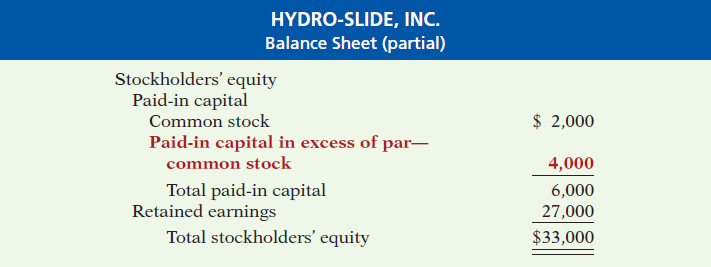
Alternative Terminology
Paid-in Capital in Excess of Par is also called Premium on Stock.
When a corporation issues stock for less than par value, it debits the account Paid-in Capital in Excess of Par—Common Stock if a credit balance exists in this account. If a credit balance does not exist, then the corporation debits to Retained Earnings the amount less than par. This situation occurs only rarely. Most states do not permit the sale of common stock below par value because stockholders may be held personally liable for the difference between the price paid upon original sale and par value.
ISSUING NO-PAR COMMON STOCK FOR CASH
When no-par common stock has a stated value, the entries are similar to those illustrated for par value stock. The corporation credits the stated value to Common Stock. Also, when the selling price of no-par stock exceeds stated value, the corporation credits the excess to Paid-in Capital in Excess of Stated Value—Common Stock.
For example, assume that instead of $1 par value stock, Hydro-Slide, Inc. has $5 stated value no-par stock and the company issues 5,000 shares at $8 per share for cash. The entry is:

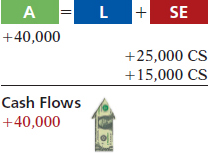
Hydro-Slide, Inc. reports Paid-in Capital in Excess of Stated Value—Common Stock as part of paid-in capital in the stockholders' equity section.
What happens when no-par stock does not have a stated value? In that case, the corporation credits the entire proceeds to Common Stock. Thus, if Hydro-Slide does not assign a stated value to its no-par stock, it records the issuance of the 5,000 shares at $8 per share for cash as follows.

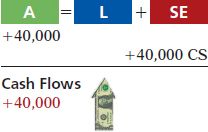
ISSUING COMMON STOCK FOR SERVICES OR NONCASH ASSETS
Corporations also may issue stock for services (compensation to attorneys or consultants) or for noncash assets (land, buildings, and equipment). In such cases, what cost should be recognized in the exchange transaction? To comply with the historical cost principle, in a noncash transaction cost is the cash equivalent price. Thus, cost is either the fair value of the consideration given up or the fair value of the consideration received, whichever is more clearly determinable.
To illustrate, assume that attorneys have helped Jordan Company incorporate. They have billed the company $5,000 for their services. They agree to accept 4,000 shares of $1 par value common stock in payment of their bill. At the time of the exchange, there is no established market price for the stock. In this case, the fair value of the consideration received, $5,000, is more clearly evident. Accordingly, Jordan Company makes the following entry.


As explained on page 547, organization costs are expensed as incurred.
In contrast, assume that Athletic Research Inc. is an existing publicly held corporation. Its $5 par value stock is actively traded at $8 per share. The company issues 10,000 shares of stock to acquire land recently advertised for sale at $90,000. The most clearly evident value in this noncash transaction is the market price of the consideration given, $80,000. The company records the transaction as follows.


As illustrated in these examples, the par value of the stock is never a factor in determining the cost of the assets received. This is also true of the stated value of no-par stock.
ANATOMY OF A FRAUD
The president, chief operating officer, and chief financial officer of SafeNet, a software encryption company, were each awarded employee stock options by the company's board of directors as part of their compensation package. Stock options enable an employee to buy a company's stock sometime in the future at the price that existed when the stock option was awarded. For example, suppose that you received stock options today, when the stock price of your company was $30. Three years later, if the stock price rose to $100, you could “exercise” your options and buy the stock for $30 per share, thereby making $70 per share. After being awarded their stock options, the three employees changed the award dates in the company's records to dates in the past, when the company's stock was trading at historical lows. For instance, using the previous example, they would choose a past date when the stock was selling for $10 per share, rather than the $30 price on the actual award date. This would increase the profit from exercising the options to $90 per share.
Total take: $1.7 million
THE MISSING CONTROL
Independent internal verification. The company's board of directors should have ensured that the awards were properly administered. For example, the date on the minutes from the board meeting could be compared to the dates that were recorded for the awards. In addition, the dates should again be confirmed upon exercise.
> DO IT!
Issuance of Stock
Cayman Corporation begins operations on March 1 by issuing 100,000 shares of $10 par value common stock for cash at $12 per share. On March 15, it issues 5,000 shares of common stock to attorneys in settlement of their bill of $50,000 for organization costs. Journalize the issuance of the shares, assuming the stock is not publicly traded.
Action Plan
![]() In issuing shares for cash, credit Common Stock for par value per share.
In issuing shares for cash, credit Common Stock for par value per share.
![]() Credit any additional proceeds in excess of par to a separate paid-in capital account.
Credit any additional proceeds in excess of par to a separate paid-in capital account.
![]() When stock is issued for services, use the cash equivalent price.
When stock is issued for services, use the cash equivalent price.
![]() For the cash equivalent price, use either the fair value of what is given up or the fair value of what is received, whichever is more clearly determinable.
For the cash equivalent price, use either the fair value of what is given up or the fair value of what is received, whichever is more clearly determinable.
Solution
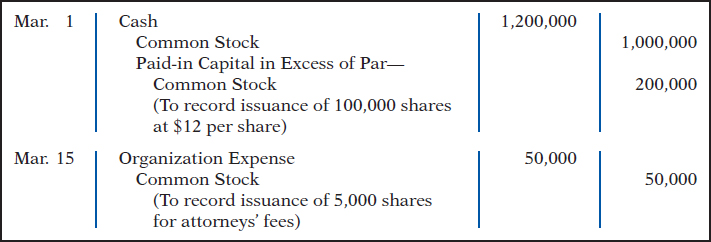
Related exercise material: BE11-2, BE11-3, BE11-4, E11-3, E11-4, E11-8, and DO IT! 11-3.
![]()
![]() 3
3
Explain the accounting for treasury stock.
Accounting for Treasury Stock
Treasury stock is a corporation's own stock that it has issued and subsequently reacquired from shareholders but not retired. A corporation may acquire treasury stock for various reasons:
- To reissue the shares to officers and employees under bonus and stock compensation plans.
- To increase trading of the company's stock in the securities market. Companies expect that buying their own stock will signal that management believes the stock is underpriced, which they hope will enhance its market price.
- To have additional shares available for use in the acquisition of other companies.
- To reduce the number of shares outstanding and thereby increase earnings per share.
Helpful Hint
Treasury shares do not have dividend rights or voting rights.
Another infrequent reason for purchasing shares is that management may want to eliminate hostile shareholders by buying them out.
Many corporations have treasury stock. For example, approximately 68% of U.S. companies have treasury stock.3 In a recent year, Nike purchased more than 6 million treasury shares.
PURCHASE OF TREASURY STOCK
Companies generally account for treasury stock by the cost method. This method uses the cost of the shares purchased to value the treasury stock. Under the cost method, the company debits Treasury Stock for the price paid to reacquire the shares. When the company disposes of the shares, it credits to Treasury Stock the same amount it paid to reacquire the shares.
To illustrate, assume that on January 1, 2015, the stockholders' equity section of Mead, Inc. has 400,000 shares authorized and 100,000 shares of $5 par value common stock outstanding (all issued at par value) and Retained Earnings of $200,000. The stockholders' equity section before purchase of treasury stock is as follows.
Illustration 11-8
Stockholders' equity with no treasury stock

On February 1, 2015, Mead acquires 4,000 shares of its stock at $8 per share. The entry is:


Mead debits Treasury Stock for the cost of the shares purchased ($32,000). Is the original paid-in capital account, Common Stock, affected? No, because the number of issued shares does not change.
In the stockholders' equity section of the balance sheet, Mead deducts treasury stock from total paid-in capital and retained earnings. Treasury Stock is a contra stockholders' equity account. Thus, the acquisition of treasury stock reduces stockholders' equity. The stockholders' equity section of Mead, Inc. after purchase of treasury stock is as follows.
Illustration 11-9
Stockholders' equity with treasury stock
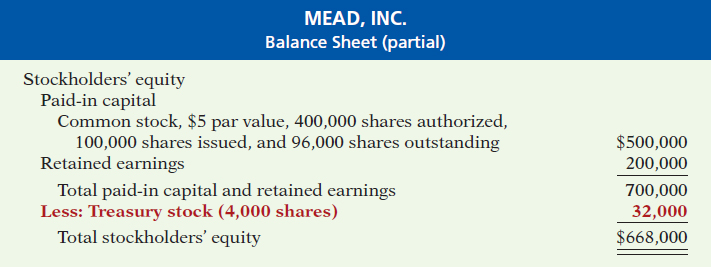
Mead discloses in the balance sheet both the number of shares issued (100,000) and the number in the treasury (4,000). The difference is the number of shares of stock outstanding (96,000). The term outstanding stock means the number of shares of issued stock that are being held by stockholders.
![]() Ethics Note
Ethics Note
The purchase of treasury stock reduces the cushion (cash available) for creditors and preferred stockholders. A restriction for the cost of treasury stock purchased is often required. The restriction is usually applied to retained earnings.
Some maintain that companies should report treasury stock as an asset because it can be sold for cash. But under this reasoning, companies would also show unissued stock as an asset, which is clearly incorrect. Rather than being an asset, treasury stock reduces stockholder claims on corporate assets. This effect is correctly shown by reporting treasury stock as a deduction from total paid-in capital and retained earnings.
ACCOUNTING ACROSS THE ORGANIZATION 
Why Did Reebok Buy Its Own Stock?

In a bold (and some would say risky) move, Reebok at one time bought back nearly a third of its shares. This repurchase of shares dramatically reduced Reebok's available cash. In fact, the company borrowed significant funds to accomplish the repurchase. In a press release, management stated that it was repurchasing the shares because it believed its stock was severely underpriced. The repurchase of so many shares was meant to signal management's belief in good future earnings.
Skeptics, however, suggested that Reebok's management was repurchasing shares to make it less likely that another company would acquire Reebok (in which case Reebok's top managers would likely lose their jobs). By depleting its cash, Reebok became a less attractive acquisition target. Acquiring companies like to purchase companies with large cash balances so they can pay off debt used in the acquisition.
 What signal might a large stock repurchase send to investors regarding management's belief about the company's growth opportunities? (See page 600.)
What signal might a large stock repurchase send to investors regarding management's belief about the company's growth opportunities? (See page 600.)
DISPOSAL OF TREASURY STOCK
Treasury stock is usually sold or retired. The accounting for its sale differs when treasury stock is sold above cost than when it is sold below cost.
SALE OF TREASURY STOCK ABOVE COST If the selling price of the treasury shares is equal to their cost, the company records the sale of the shares by a debit to Cash and a credit to Treasury Stock. When the selling price of the shares is greater than their cost, the company credits the difference to Paid-in Capital from Treasury Stock.
Helpful Hint
Treasury stock transactions are classified as capital stock transactions. As in the case when stock is issued, the income statement is not involved.
To illustrate, assume that on July 1, Mead, Inc. sells for $10 per share the 1,000 shares of its treasury stock previously acquired at $8 per share. The entry is as follows.


Mead does not record a $2,000 gain on sale of treasury stock because (1) gains on sales occur when assets are sold, and treasury stock is not an asset, and (2) a corporation does not realize a gain or suffer a loss from stock transactions with its own stockholders. Thus, companies should not include in net income any paid-in capital arising from the sale of treasury stock. Instead, they report Paid-in Capital from Treasury Stock separately on the balance sheet, as a part of paid-in capital.
SALE OF TREASURY STOCK BELOW COST When a company sells treasury stock below its cost, it usually debits to Paid-in Capital from Treasury Stock the excess of cost over selling price. Thus, if Mead, Inc. sells an additional 800 shares of treasury stock on October 1 at $7 per share, it makes the following entry.


Observe the following from the two sales entries. (1) Mead credits Treasury Stock at cost in each entry. (2) Mead uses Paid-in Capital from Treasury Stock for the difference between cost and the resale price of the shares. (3) The original paid-in capital account, Common Stock, is not affected. The sale of treasury stock increases both total assets and total stockholders' equity.
After posting the foregoing entries, the treasury stock accounts will show the following balances on October 1.
Illustration 11-10
Treasury stock accounts

When a company fully depletes the credit balance in Paid-in Capital from Treasury Stock, it debits to Retained Earnings any additional excess of cost over selling price. To illustrate, assume that Mead, Inc. sells its remaining 2,200 shares at $7 per share on December 1. The excess of cost over selling price is $2,200 [2,200 × ($8 − $7)]. In this case, Mead debits $1,200 of the excess to Paid-in Capital from Treasury Stock. It debits the remainder to Retained Earnings. The entry is:


> DO IT!
Treasury Stock
Santa Anita Inc. purchases 3,000 shares of its $50 par value common stock for $180,000 cash on July 1. It will hold the shares in the treasury until resold. On November 1, the corporation sells 1,000 shares of treasury stock for cash at $70 per share. Journalize the treasury stock transactions.
Action Plan
![]() Record the purchase of treasury stock at cost.
Record the purchase of treasury stock at cost.
![]() When treasury stock is sold above its cost, credit the excess of the selling price over cost to Paid-in Capital from Treasury Stock.
When treasury stock is sold above its cost, credit the excess of the selling price over cost to Paid-in Capital from Treasury Stock.
![]() When treasury stock is sold below its cost, debit the excess of cost over selling price to Paid-in Capital from Treasury Stock.
When treasury stock is sold below its cost, debit the excess of cost over selling price to Paid-in Capital from Treasury Stock.
Solution

Related exercise material: BE11-5, E11-5, E11-7, E11-9, and DO IT! 11-4.
![]()
![]() 4
4
Differentiate preferred stock from common stock.
Accounting for Preferred Stock
To appeal to a larger segment of potential investors, a corporation may issue an additional class of stock, called preferred stock. Preferred stock has contractual provisions that give it some preference or priority over common stock. Typically, preferred stockholders have a priority as to (1) distributions of earnings (dividends) and (2) assets in the event of liquidation. However, they generally do not have voting rights.
Like common stock, corporations may issue preferred stock for cash or for non-cash assets. The entries for these transactions are similar to the entries for common stock. When a corporation has more than one class of stock, each paid-in capital account title should identify the stock to which it relates. A company might have the following accounts: Preferred Stock, Common Stock, Paid-in Capital in Excess of Par—Preferred Stock, and Paid-in Capital in Excess of Par—Common Stock.
For example, if Stine Corporation issues 10,000 shares of $10 par value preferred stock for $12 cash per share, the entry to record the issuance is:


Preferred stock may have either a par value or no-par value. In the stockholders' equity section of the balance sheet, companies list preferred stock first because of its dividend and liquidation preferences over common stock.
DIVIDEND PREFERENCES
As indicated above, preferred stockholders have the right to receive dividends before common stockholders. For example, if the dividend rate on preferred stock is $5 per share, common shareholders will not receive any dividends in the current year until preferred stockholders have received $5 per share. The first claim to dividends does not, however, guarantee the payment of dividends. Dividends depend on many factors, such as adequate retained earnings and availability of cash. If a company does not pay dividends to preferred stockholders, it cannot of course pay dividends to common stockholders.

For preferred stock, companies state the per share dividend amount as a percentage of the par value or as a specified amount. For example, Earthlink specifies a 3% dividend on its $100 par value preferred. PepsiCo pays $4.56 per share on its no-par value stock.
CUMULATIVE DIVIDEND Preferred stock often contains a cumulative dividend feature. This right means that preferred stockholders must be paid both current-year dividends and any unpaid prior-year dividends before common stockholders receive dividends. When preferred stock is cumulative, preferred dividends not declared in a given period are called dividends in arrears.
To illustrate, assume that Scientific Leasing has 5,000 shares of 7%, $100 par value, cumulative preferred stock outstanding. Each $100 share pays a $7 dividend (.07 × $100). The annual dividend is $35,000 (5,000 × $7 per share). If dividends are two years in arrears, preferred stockholders are entitled to receive the following dividends in the current year.
Illustration 11-11
Computation of total dividends to preferred stock

The company cannot pay dividends to common stockholders until it pays the entire preferred dividend. In other words, companies cannot pay dividends to common stockholders while any preferred dividends are in arrears.
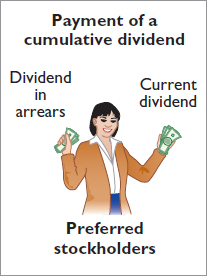
Are dividends in arrears considered a liability? No—no payment obligation exists until the board of directors declares a dividend. However, companies should disclose in the notes to the financial statements the amount of dividends in arrears. Doing so enables investors to assess the potential impact of this commitment on the corporation's financial position.
The investment community does not look favorably on companies that are unable to meet their dividend obligations. As a financial officer noted in discussing one company's failure to pay its cumulative preferred dividend for a period of time, “Not meeting your obligations on something like that is a major black mark on your record.” The accounting entries for preferred stock dividends are explained later in this chapter.
LIQUIDATION PREFERENCE
Most preferred stocks also have a preference on corporate assets if the corporation fails. This feature provides security for the preferred stockholder. The preference to assets may be for the par value of the shares or for a specified liquidating value. For example, Commonwealth Edison's preferred stock entitles its holders to receive $31.80 per share, plus accrued and unpaid dividends, in the event of liquidation. The liquidation preference establishes the respective claims of creditors and preferred stockholders in litigation involving bankruptcy lawsuits.
![]() 5
5
Prepare the entries for cash dividends and stock dividends.
Dividends
A dividend is a corporation's distribution of cash or stock to its stockholders on a pro rata (proportional to ownership) basis. Pro rata means that if you own 10% of the common shares, you will receive 10% of the dividend. Dividends can take four forms: cash, property, scrip (a promissory note to pay cash), or stock. Cash dividends predominate in practice. Also, companies declare stock dividends with some frequency. These two forms of dividends are the focus of discussion in this chapter.
Investors are very interested in a company's dividend practices. In the financial press, dividends are generally reported quarterly as a dollar amount per share. (Sometimes they are reported on an annual basis.) For example, Nike's quarterly dividend rate in the fourth quarter of 2012 was 21 cents per share. The dividend rate for the fourth quarter of 2012 for GE was 19 cents, and for ConAgra Foods it was 25 cents.
Cash Dividends
A cash dividend is a pro rata distribution of cash to stockholders. Cash dividends are not paid on treasury shares. For a corporation to pay a cash dividend, it must have the following.
- Retained earnings. The legality of a cash dividend depends on the laws of the state in which the company is incorporated. Payment of cash dividends from retained earnings is legal in all states. In general, cash dividend distributions from only the balance in common stock (legal capital) are illegal.
A dividend declared out of paid-in capital is termed a liquidating dividend. Such a dividend reduces or “liquidates” the amount originally paid in by stockholders. Statutes vary considerably with respect to cash dividends based on paid-in capital in excess of par or stated value. Many states permit such dividends.
- Adequate cash. The legality of a dividend and the ability to pay a dividend are two different things. For example, Nike, with retained earnings of over $5.8 billion, could legally declare a dividend of at least $5.8 billion. But Nike's cash balance is only $1.9 billion.
Before declaring a cash dividend, a company's board of directors must carefully consider both current and future demands on the company's cash resources. In some cases, current liabilities may make a cash dividend inappropriate. In other cases, a major plant expansion program may warrant only a relatively small dividend.
- Declared dividends. A company does not pay dividends unless its board of directors decides to do so, at which point the board “declares” the dividend. The board of directors has full authority to determine the amount of income to distribute in the form of a dividend and the amount to retain in the business. Dividends do not accrue like interest on a note payable, and they are not a liability until declared.
The amount and timing of a dividend are important issues for management to consider. The payment of a large cash dividend could lead to liquidity problems for the company. On the other hand, a small dividend or a missed dividend may cause unhappiness among stockholders. Many stockholders expect to receive a reasonable cash payment from the company on a periodic basis. Many companies declare and pay cash dividends quarterly. On the other hand, a number of high-growth companies pay no dividends, preferring to conserve cash to finance future capital expenditures.
ENTRIES FOR CASH DIVIDENDS
Three dates are important in connection with dividends: (1) the declaration date, (2) the record date, and (3) the payment date. Normally, there are two to four weeks between each date. Companies make accounting entries on the declaration date and the payment date.
On the declaration date, the board of directors formally declares (authorizes) the cash dividend and announces it to stockholders. The declaration of a cash dividend commits the corporation to a legal obligation. The company must make an entry to recognize the increase in Cash Dividends and the increase in the liability Dividends Payable.
To illustrate, assume that on December 1, 2015, the directors of Media General declare a 50 cents per share cash dividend on 100,000 shares of $10 par value common stock. The dividend is $50,000 (100,000 × $0.50). The entry to record the declaration is:

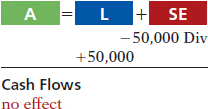
Media General debits the account Cash Dividends. Cash dividends decrease retained earnings. We use the specific title Cash Dividends to differentiate it from other types of dividends, such as stock dividends. Dividends Payable is a current liability. It will normally be paid within the next several months. When using a Cash Dividends account, the company transfers the balance of that account to Retained Earnings at the end of the year by a closing entry. For homework problems, you should use the Cash Dividends account for recording dividend declarations.
At the record date, the company determines ownership of the outstanding shares for dividend purposes. The stockholders' records maintained by the corporation supply this information. In the interval between the declaration date and the record date, the corporation updates its stock ownership records. For Media General, the record date is December 22. No entry is required on this date because the corporation's liability recognized on the declaration date is unchanged.
Helpful Hint
The purpose of the record date is to identify the persons or entities that will receive the dividend, not to determine the amount of the dividend liability.
![]()
On the payment date, the company makes cash dividend payments to the stockholders of record (as of December 22) and records the payment of the dividend. If January 20 is the payment date for Media General, the entry on that date is:


Note that payment of the dividend reduces both current assets and current liabilities. It has no effect on stockholders' equity. The cumulative effect of the declaration and payment of a cash dividend is to decrease both stockholders' equity and total assets. Illustration 11-12 (page 564) summarizes the three important dates associated with dividends for Media General.
Illustration 11-12
Key dividend dates

ALLOCATING CASH DIVIDENDS BETWEEN PREFERRED AND COMMON STOCK
As explained earlier in the chapter, preferred stock has priority over common stock in regard to dividends. Holders of cumulative preferred stock must be paid any unpaid prior-year dividends and their current year's dividend before common stockholders receive dividends.
To illustrate, assume that at December 31, 2015, IBR Inc. has 1,000 shares of 8%, $100 par value cumulative preferred stock. It also has 50,000 shares of $10 par value common stock outstanding. The dividend per share for preferred stock is $8 ($100 par value × 8%). The required annual dividend for preferred stock is therefore $8,000 (1,000 shares × $8). At December 31, 2015, the directors declare a $6,000 cash dividend. In this case, the entire dividend amount goes to preferred stockholders because of their dividend preference. The entry to record the declaration of the dividend is:


Because of the cumulative feature, dividends of $2 ($8 − $6) per share are in arrears on preferred stock for 2015. IBR must pay these dividends to preferred stockholders before it can pay any future dividends to common stockholders. IBR should disclose dividends in arrears in the financial statements.
At December 31, 2016, IBR declares a $50,000 cash dividend. The allocation of the dividend to the two classes of stock is as follows.
Illustration 11-13
Allocating dividends to preferred and common stock

The entry to record the declaration of the dividend is:


If IBR's preferred stock is not cumulative, preferred stockholders receive only $8,000 in dividends in 2016. Common stockholders receive $42,000.
> DO IT!
Dividends on Preferred and Common Stock
MasterMind Corporation has 2,000 shares of 6%, $100 par value preferred stock outstanding at December 31, 2015. At December 31, 2015, the company declared a $60,000 cash dividend. Determine the dividend paid to preferred stockholders and common stockholders under each of the following scenarios.
- The preferred stock is noncumulative, and the company has not missed any dividends in previous years.
- The preferred stock is noncumulative, and the company did not pay a dividend in each of the two previous years.
- The preferred stock is cumulative, and the company did not pay a dividend in each of the two previous years.
Action Plan
![]() Determine dividends on preferred shares by multiplying the dividend rate times the par value of the stock times the number of preferred shares.
Determine dividends on preferred shares by multiplying the dividend rate times the par value of the stock times the number of preferred shares.
![]() Understand the cumulative feature. If preferred stock is cumulative, then any missed dividends (dividends in arrears) and the current year's dividend must be paid to preferred stockholders before dividends are paid to common stockholders.
Understand the cumulative feature. If preferred stock is cumulative, then any missed dividends (dividends in arrears) and the current year's dividend must be paid to preferred stockholders before dividends are paid to common stockholders.
Solution
- The company has not missed past dividends and the preferred stock is noncumulative. Thus, the preferred stockholders are paid only this year's dividend. The dividend paid to preferred stockholders would be $12,000 (2,000 × .06 × $100). The dividend paid to common stockholders would be $48,000 ($60,000 − $12,000).
- The preferred stock is noncumulative. Thus, past unpaid dividends do not have to be paid. The dividend paid to preferred stockholders would be $12,000 (2,000 × .06 × $100). The dividend paid to common stockholders would be $48,000 ($60,000 − $12,000).
- The preferred stock is cumulative. Thus, dividends that have been missed (dividends in arrears) must be paid. The dividend paid to preferred stockholders would be $36,000 (3 × 2,000 × .06 × $100). The dividend paid to common stockholders would be $24,000 ($60,000 − $36,000).
Related exercise material: BE11-7, E11-6, E11-13, and DO IT! 11-5.
![]()
Stock Dividends
A stock dividend is a pro rata (proportional to ownership) distribution of the corporation's own stock to stockholders. Whereas a company pays cash in a cash dividend, a company issues shares of stock in a stock dividend. A stock dividend results in a decrease in retained earnings and an increase in paid-in capital. Unlike a cash dividend, a stock dividend does not decrease total stockholders' equity or total assets.
To illustrate, assume that you have a 2% ownership interest in Cetus Inc. That is, you own 20 of its 1,000 shares of common stock. If Cetus declares a 10% stock dividend, it would issue 100 shares (1,000 × 10%) of stock. You would receive two shares (2% × 100). Would your ownership interest change? No, it would remain at 2% (22 ÷ 1,100). You now own more shares of stock, but your ownership interest has not changed.
Cetus has disbursed no cash and has assumed no liabilities. What, then, are the purposes and benefits of a stock dividend? Corporations issue stock dividends generally for one or more of the following reasons.
- To satisfy stockholders' dividend expectations without spending cash.
- To increase the marketability of the corporation's stock. When the number of shares outstanding increases, the market price per share decreases. Decreasing the market price of the stock makes it easier for smaller investors to purchase the shares.
- To emphasize that a company has permanently reinvested in the business a portion of stockholders' equity, which therefore is unavailable for cash dividends.
When the dividend is declared, the board of directors determines the size of the stock dividend and the value assigned to each dividend.
Generally, if the company issues a small stock dividend (less than 20–25% of the corporation's issued stock), the value assigned to the dividend is the fair value per share. This treatment is based on the assumption that a small stock dividend will have little effect on the market price of the shares previously outstanding. Thus, many stockholders consider small stock dividends to be distributions of earnings equal to the market price of the shares distributed. If a company issues a large stock dividend (greater than 20–25%), the price assigned to the dividend is the par or stated value. Small stock dividends predominate in practice. Thus, we will illustrate only entries for small stock dividends.
ENTRIES FOR STOCK DIVIDENDS
To illustrate the accounting for small stock dividends, assume that Medland Corporation has a balance of $300,000 in retained earnings. It declares a 10% stock dividend on its 50,000 shares of $10 par value common stock. The current market price of its stock is $15 per share. The number of shares to be issued is 5,000 (10% × 50,000). Therefore, the total amount to be debited to Stock Dividends is $75,000 (5,000 × $15). The entry to record the declaration of the stock dividend is as follows.

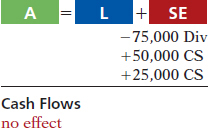
Medland debits Stock Dividends for the market price of the stock issued ($15 × 5,000). (Similar to Cash Dividends, Stock Dividends decrease retained earnings.) Medland also credits Common Stock Dividends Distributable for the par value of the dividend shares ($10 × 5,000) and credits Paid-in Capital in Excess of Par—Common Stock for the excess of the market price over par ($5 × 5,000).
Common Stock Dividends Distributable is a stockholders' equity account. It is not a liability because assets will not be used to pay the dividend. If the company prepares a balance sheet before it issues the dividend shares, it reports the distributable account under paid-in capital as shown in Illustration 11-14.
Illustration 11-14
Statement presentation of common stock dividends distributable

When Medland issues the dividend shares, it debits Common Stock Dividends Distributable and credits Common Stock, as follows.

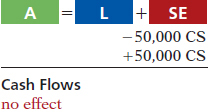
EFFECTS OF STOCK DIVIDENDS
How do stock dividends affect stockholders' equity? They change the composition of stockholders' equity because they transfer to paid-in capital a portion of retained earnings. However, total stockholders' equity remains the same. Stock dividends also have no effect on the par or stated value per share. But, the number of shares outstanding increases. Illustration 11-15 shows these effects for Medland Corporation.
Illustration 11-15
Stock dividend effects

In this example, total paid-in capital increases by $75,000 (50,000 shares × 10% × $15) and retained earnings decreases by the same amount. Note also that total stockholders' equity remains unchanged at $800,000. The number of shares increases by 5,000 (50,000 × 10%).
Stock Splits
A stock split, like a stock dividend, involves issuance of additional shares to stockholders according to their percentage ownership. However, a stock split results in a reduction in the par or stated value per share. The purpose of a stock split is to increase the marketability of the stock by lowering its market price per share. This, in turn, makes it easier for the corporation to issue additional stock.
Helpful Hint
A stock split changes the par value per share but does not affect any balances in stockholders' equity.
The effect of a split on market price is generally inversely proportional to the size of the split. For example, after a 2-for-1 stock split, the market price of Nike's stock fell from $111 to approximately $55. The lower market price stimulated market activity. Within one year, the stock was trading above $100 again. Illustration 11-16 shows the effect of a 4-for-1 stock split for stockholders.
Illustration 11-16
Effect of stock split for stockholders

In a stock split, the number of shares increases in the same proportion that par or stated value per share decreases. For example, in a 2-for-1 split, one share of $10 par value stock is exchanged for two shares of $5 par value stock. A stock split does not have any effect on total paid-in capital, retained earnings, or total stockholders' equity. But, the number of shares outstanding increases, and par value per share decreases. Illustration 11-17 shows these effects for Medland Corporation, assuming that it splits its 50,000 shares of common stock on a 2-for-1 basis.
Illustration 11-17
Stock split effects
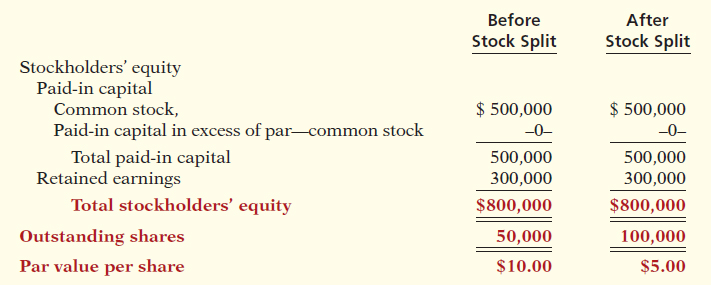
A stock split does not affect the balances in any stockholders' equity accounts. Therefore, it is not necessary to journalize a stock split.
Illustration 11-18 summarizes the differences between stock splits and stock dividends.
Illustration 11-18
Differences between the effects of stock splits and stock dividends

INVESTOR INSIGHT 
A No-Split Philosophy
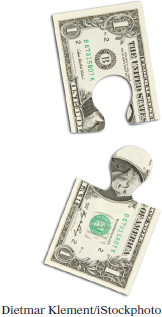
Warren Buffett's company, Berkshire Hathaway, has two classes of shares. Until recently, the company had never split either class of stock. As a result, the class A stock had a market price of $97,000 and the class B sold for about $3,200 per share. Because the price per share is so high, the stock does not trade as frequently as the stock of other companies. Buffett has always opposed stock splits because he feels that a lower stock price attracts short-term investors. He appears to be correct. For example, while more than 6 million shares of IBM are exchanged on the average day, only about 1,000 class A shares of Berkshire are traded. Despite Buffett's aversion to splits, in order to accomplish a recent acquisition, Berkshire decided to split its class B shares 50 to 1.
Source: Scott Patterson, “Berkshire Nears Smaller Baby B's,” Wall Street Journal Online (January 19, 2010).
 Why does Warren Buffett usually oppose stock splits? (See page 600.)
Why does Warren Buffett usually oppose stock splits? (See page 600.)
Stock Dividends and Stock Splits
Sing CD Company has had five years of record earnings. Due to this success, the market price of its 500,000 shares of $2 par value common stock has tripled from $15 per share to $45. During this period, paid-in capital remained the same at $2,000,000. Retained earnings increased from $1,500,000 to $10,000,000. President Joan Elbert is considering either a 10% stock dividend or a 2-for-1 stock split. She asks you to show the before-and-after effects of each option on retained earnings and total stockholders' equity.
Action Plan
![]() Calculate the stock dividend's effect on retained earnings by multiplying the number of new shares times the market price of the stock (or par value for a large stock dividend).
Calculate the stock dividend's effect on retained earnings by multiplying the number of new shares times the market price of the stock (or par value for a large stock dividend).
![]() Recall that a stock dividend increases the number of shares without affecting total stockholders' equity.
Recall that a stock dividend increases the number of shares without affecting total stockholders' equity.
![]() Recall that a stock split only increases the number of shares outstanding and decreases the par value per share.
Recall that a stock split only increases the number of shares outstanding and decreases the par value per share.
Solution
The stock dividend amount is $2,250,000 [(500,000 × 10%) × $45]. The new balance in retained earnings is $7,750,000 ($10,000,000 − $2,250,000). The retained earnings balance after the stock split is the same as it was before the split: $10,000,000. Total stockholders' equity does not change. The effects on the stockholders' equity accounts are as follows.

Related exercise material: BE11-8, BE11-9, E11-14, E11-15, and DO IT! 11-6.
![]()
![]() 6
6
Identify the items reported in a retained earnings statement.
Retained Earnings
Recall that retained earnings is net income that a company retains in the business. The balance in retained earnings is part of the stockholders' claim on the total assets of the corporation. It does not, though, represent a claim on any specific asset. Nor can the amount of retained earnings be associated with the balance of any asset account. For example, a $100,000 balance in retained earnings does not mean that there should be $100,000 in cash. The reason is that the company may have used the cash resulting from the excess of revenues over expenses to purchase buildings, equipment, and other assets.
To demonstrate that retained earnings and cash may be quite different, Illustration 11-19 shows recent amounts of retained earnings and cash in selected companies.
Illustration 11-19
Retained earnings and cash balances

Remember that when a company has net income, it closes net income to retained earnings. The closing entry is a debit to Income Summary and a credit to Retained Earnings.
When a company has a net loss (expenses exceed revenues), it also closes this amount to retained earnings. The closing entry in this case is a debit to Retained Earnings and a credit to Income Summary. This is done even if it results in a debit balance in Retained Earnings. Companies do not debit net losses to paid-in capital accounts. To do so would destroy the distinction between paid-in and earned capital. If cumulative losses exceed cumulative income over a company's life, a debit balance in Retained Earnings results. A debit balance in Retained Earnings is identified as a deficit. A company reports a deficit as a deduction in the stockholders' equity section, as shown below.
Helpful Hint
Remember that Retained Earnings is a stockholders' equity account, whose normal balance is a credit.
Illustration 11-20
Stockholders' equity with deficit

Retained Earnings Restrictions
The balance in retained earnings is generally available for dividend declarations. Some companies state this fact. For example, Lockheed Martin Corporation states the following in the notes to its financial statements.
Illustration 11-21
Disclosure of unrestricted retained earnings

In some cases, there may be retained earnings restrictions. These make a portion of the retained earnings balance currently unavailable for dividends. Restrictions result from one or more of the following causes.
- Legal restrictions. Many states require a corporation to restrict retained earnings for the cost of treasury stock purchased. The restriction keeps intact the corporation's legal capital that is being temporarily held as treasury stock. When the company sells the treasury stock, the restriction is lifted.
- Contractual restrictions. Long-term debt contracts may restrict retained earnings as a condition for the loan. The restriction limits the use of corporate assets for payment of dividends. Thus, it increases the likelihood that the corporation will be able to meet required loan payments.
- Voluntary restrictions. The board of directors may voluntarily create retained earnings restrictions for specific purposes. For example, the board may authorize a restriction for future plant expansion. By reducing the amount of retained earnings available for dividends, the company makes more cash available for the planned expansion.
Companies generally disclose retained earnings restrictions in the notes to the financial statements. For example, as shown in Illustration 11-22, Tektronix Inc., a manufacturer of electronic measurement devices, had total retained earnings of $774 million, but the unrestricted portion was only $223.8 million.
Illustration 11-22
Disclosure of restriction

Prior Period Adjustments
Suppose that a corporation has closed its books and issued financial statements. The corporation then discovers that it made a material error in reporting net income of a prior year. How should the company record this situation in the accounts and report it in the financial statements?
The correction of an error in previously issued financial statements is known as a prior period adjustment. The company makes the correction directly to Retained Earnings because the effect of the error is now in this account. The net income for the prior period has been recorded in retained earnings through the journalizing and posting of closing entries.
To illustrate, assume that General Microwave discovers in 2015 that it understated depreciation expense on equipment in 2014 by $300,000 due to computational errors. These errors overstated both net income for 2014 and the current balance in retained earnings. The entry for the prior period adjustment, ignoring all tax effects, is as follows.


A debit to an income statement account in 2015 is incorrect because the error pertains to a prior year.
Companies report prior period adjustments in the retained earnings statement.4 They add (or deduct, as the case may be) these adjustments from the beginning retained earnings balance. This results in an adjusted beginning balance. For example, assuming a beginning balance of $800,000 in retained earnings, General Microwave reports the prior period adjustment as follows.
Illustration 11-23
Statement presentation of prior period adjustments

Again, reporting the correction in the current year's income statement would be incorrect because it applies to a prior year's income statement.
Retained Earnings Statement
The retained earnings statement shows the changes in retained earnings during the year. The company prepares the statement from the Retained Earnings account. Illustration 11-24 shows (in T-account form) transactions that affect retained earnings.
Illustration 11-24
Debits and credits to retained earnings

As indicated, net income increases retained earnings, and a net loss decreases retained earnings. Prior period adjustments may either increase or decrease retained earnings. Both cash dividends and stock dividends decrease retained earnings. The circumstances under which treasury stock transactions decrease retained earnings are explained on page 559.
A complete retained earnings statement for Graber Inc., based on assumed data, is as follows.
Illustration 11-25
Retained earnings statement

> DO IT!
Retained Earnings Statement
Vega Corporation has retained earnings of $5,130,000 on January 1, 2015. During the year, Vega earned $2,000,000 of net income. It declared and paid a $250,000 cash dividend. In 2015, Vega recorded an adjustment of $180,000 due to the understatement (from a mathematical error) of 2014 depreciation expense. Prepare a retained earnings statement for 2015.
Action Plan
![]() Recall that a retained earnings statement begins with retained earnings, as reported at the end of the previous year.
Recall that a retained earnings statement begins with retained earnings, as reported at the end of the previous year.
![]() Add or subtract any prior period adjustments to arrive at the adjusted beginning figure.
Add or subtract any prior period adjustments to arrive at the adjusted beginning figure.
![]() Add net income and subtract dividends declared to arrive at the ending balance in retained earnings.
Add net income and subtract dividends declared to arrive at the ending balance in retained earnings.
Solution
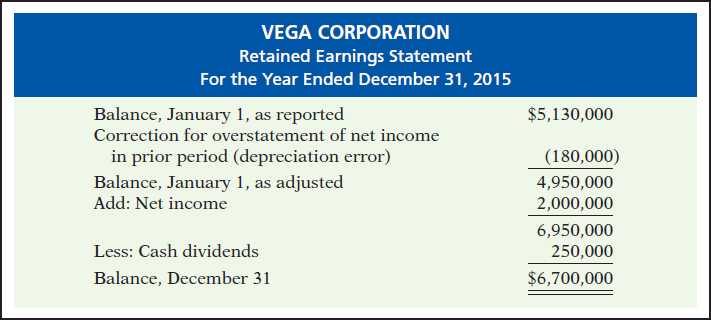
Related exercise material: BE11-10, BE11-11, BE11-12, E11-17, E11-18, and DO IT! 11-7.
![]()
![]() 7
7
Prepare and analyze a comprehensive stockholders' equity section.
Statement Presentation and Analysis
In the stockholders' equity section of the balance sheet, paid-in capital and retained earnings are reported. The specific sources of paid-in capital are identified. Within paid-in capital, two classifications are recognized:
- Capital stock. This category consists of preferred and common stock. Preferred stock is shown before common stock because of its preferential rights. Par value, shares authorized, shares issued, and shares outstanding are reported for each class of stock.
- Additional paid-in capital. This includes the excess of amounts paid over par or stated value and paid-in capital from treasury stock.
Presentation
Illustration 11-26 presents the stockholders' equity section of Graber Inc.'s balance sheet. Note the following: (1) “Common stock dividends distributable” is shown under “Capital stock,” in “Paid-in capital.” (2) A note (Note R) discloses a retained earnings restriction.
Illustration 11-26
Comprehensive stockholders' equity section
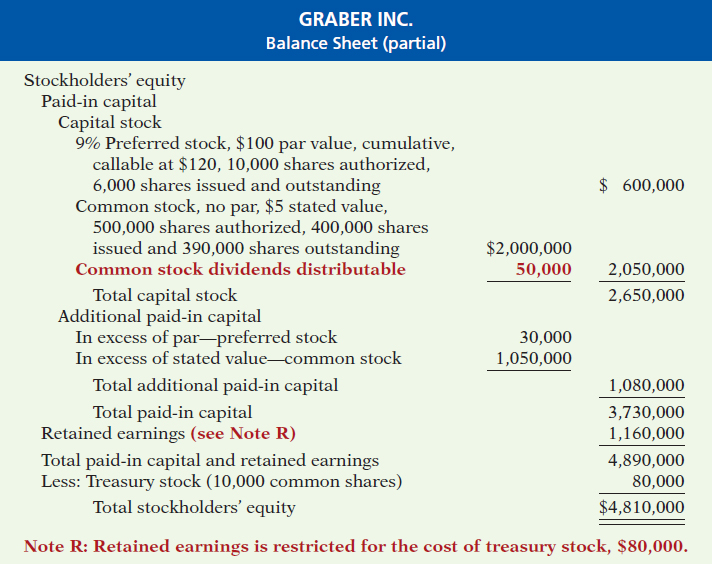
The stockholders' equity section of Graber Inc. in Illustration 11-26 includes most of the accounts discussed in this chapter. The disclosures pertaining to Graber's common stock indicate that the company issued 400,000 shares; 100,000 shares are unissued (500,000 authorized less 400,000 issued); and 390,000 shares are outstanding (400,000 issued less 10,000 shares in treasury).
Published annual reports often combine and report as a single amount the individual sources of additional paid-in capital, as shown in Illustration 11-27 (page 574). In addition, authorized shares are sometimes not reported.
Illustration 11-27
Published stockholders' equity section

In practice, companies sometimes use the term “Capital surplus” in place of “Additional paid-in capital,” and “Earned surplus” in place of “Retained earnings.” The use of the term “surplus” suggests that the company has available an excess amount of funds. Such is not necessarily the case. Therefore, the term “surplus” should not be employed in accounting. Unfortunately, a number of companies still do use it.
Instead of presenting a detailed stockholders' equity section in the balance sheet and a retained earnings statement, many companies prepare a stockholders' equity statement. This statement shows the changes (1) in each stockholders' equity account and (2) in total that occurred during the year. Examples of stockholders' equity statements appear for Apple in Appendix A and for Hampton Corporation in an appendix to this chapter (Illustration 11A-1).
Analysis
Investors and analysts can measure profitability from the viewpoint of the common stockholder by the return on common stockholders' equity. This ratio, as shown in Illustration 11-28, indicates how many dollars of net income the company earned for each dollar invested by the common stockholders. It is computed by dividing net income available to common stockholders (which is net income minus preferred dividends) by average common stockholders' equity.
To illustrate, Walt Disney Company's beginning-of-the-year and end-of-the-year common stockholders' equity were $31,820 and $30,753 million, respectively. Its net income was $4,687 million, and no preferred stock was outstanding. The return on common stockholders' equity is computed as follows.
Illustration 11-28
Return on common stockholders' equity and computation

As shown above, if a company has preferred stock, we would deduct the amount of preferred dividends from the company's net income to compute income available to common stockholders. Also, the par value of preferred stock is deducted from total stockholders' equity when computing the average common stockholders' equity.
Stockholders' Equity and EPS
On January 1, 2015, Siena Corporation purchased 2,000 shares of treasury stock. Other information regarding Siena Corporation is provided below.

Compute (a) return on common stockholders' equity for each year, and (b) discuss its change from 2014 to 2015.
Action Plan
![]() Determine return on common stockholders' equity by dividing net income available to common stockholders by average common stockholders' equity.
Determine return on common stockholders' equity by dividing net income available to common stockholders by average common stockholders' equity.
Solution
- (a)

- (b) Between 2014 and 2015, return on common stockholders' equity improved from 20% to 25%. While this would appear to be good news for the company's common stockholders, this increase should be carefully evaluated. It is important to note that net income did not change during this period. The increase in the ratio was due to the purchase of treasury shares, which reduced the denominator of the ratio. As the company repurchases its own shares, it becomes more reliant on debt and thus increases its risk.
Related exercise material: E11-22 and DO IT! 11-8.
![]()
> Comprehensive DO IT!
Rolman Corporation is authorized to issue 1,000,000 shares of $5 par value common stock. In its first year, the company has the following stock transactions.
| Jan. 10 | Issued 400,000 shares of stock at $8 per share. |
| July 1 | Issued 100,000 shares of stock for land. The land had an asking price of $900,000. The stock is currently selling on a national exchange at $8.25 per share. |
| Sept. 1 | Purchased 10,000 shares of common stock for the treasury at $9 per share. |
| Dec. 1 | Sold 4,000 shares of the treasury stock at $10 per share. |
Instructions
- (a) Journalize the transactions.
- (b) Prepare the stockholders' equity section assuming the company had retained earnings of $200,000 at December 31.
Action Plan
![]() When common stock has a par value, credit Common Stock for par value.
When common stock has a par value, credit Common Stock for par value.
![]() Use fair value in a noncash transaction.
Use fair value in a noncash transaction.
![]() Debit and credit the Treasury Stock account at cost.
Debit and credit the Treasury Stock account at cost.
![]() Record differences between the cost and selling price of treasury stock in stockholders' equity accounts, not as gains or losses.
Record differences between the cost and selling price of treasury stock in stockholders' equity accounts, not as gains or losses.
Solution to Comprehensive DO IT!


![]()
SUMMARY OF LEARNING OBJECTIVES 
1 Identify the major characteristics of a corporation. The major characteristics of a corporation are separate legal existence, limited liability of stockholders, transferable ownership rights, ability to acquire capital, continuous life, corporation management, government regulations, and additional taxes.
2 Record the issuance of common stock. When companies record the issuance of common stock for cash, they credit the par value of the shares to Common Stock. They record in a separate paid-in capital account the portion of the proceeds that is above or below par value. When no-par common stock has a stated value, the entries are similar to those for par value stock. When no-par stock does not have a stated value, companies credit the entire proceeds to Common Stock.
3 Explain the accounting for treasury stock. The cost method is generally used in accounting for treasury stock. Under this approach, companies debit Treasury Stock at the price paid to reacquire the shares. They credit the same amount to Treasury Stock when they sell the shares. The difference between the sales price and cost is recorded in stockholders' equity accounts, not in income statement accounts.
4 Differentiate preferred stock from common stock. Preferred stock has contractual provisions that give it priority over common stock in certain areas. Typically, preferred stockholders have preferences (1) to dividends and (2) to assets in liquidation. They usually do not have voting rights.
5 Prepare the entries for cash dividends and stock dividends. Companies make entries for both cash and stock dividends at the declaration date and at the payment date. At the declaration date, the entries are: cash dividend—debit Cash Dividends and credit Dividends Payable; small stock dividend—debit Stock Dividends, credit Paid-in Capital in Excess of Par (or Stated Value)—Common Stock, and credit Common Stock Dividends Distributable. At the payment date, the entries for cash and stock dividends are: cash dividend—debit Dividends Payable and credit Cash; small stock dividend—debit Common Stock Dividends Distributable and credit Common Stock.
6 Identify the items reported in a retained earnings statement. Companies report each of the individual debits and credits to retained earnings in the retained earnings statement. Additions consist of net income and prior period adjustments to correct understatements of prior years' net income. Deductions consist of net loss, adjustments to correct overstatements of prior years' net income, cash and stock dividends, and some disposals of treasury stock.
7 Prepare and analyze a comprehensive stockholders' equity section. In the stockholders' equity section, paid-in capital and retained earnings are reported and specific sources of paid-in capital are identified. Within paid-in capital, two classifications are shown: capital stock and additional paid-in capital. If a corporation has treasury stock, the cost of treasury stock is deducted from total paid-in capital and retained earnings to obtain total stockholders' equity. One measure of profitability is the return on common stockholders' equity. It is calculated by dividing net income minus preferred dividends by average common stockholders' equity.
GLOSSARY
Authorized stock The amount of stock that a corporation is authorized to sell as indicated in its charter. (p. 549).
Cash dividend A pro rata distribution of cash to stock-holders. (p. 562).
Charter A document that is issued by the state to set forth important terms and features regarding the creation of a corporation. (p. 546).
Corporation A business organized as a legal entity separate and distinct from its owners under state corporation law. (p. 544).
Cumulative dividend A feature of preferred stock entitling the stockholder to receive current and unpaid prior-year dividends before common stockholders receive dividends. (p. 561).
Declaration date The date the board of directors formally declares (authorizes) a dividend and announces it to stockholders. (p. 563).
Deficit A debit balance in Retained Earnings. (p. 570).
Dividend A corporation's distribution of cash or stock to its stockholders on a pro rata (proportional) basis. (p. 562).
Liquidating dividend A dividend declared out of paid-in capital. (p. 562).
No-par value stock Capital stock that has not been assigned a value in the corporate charter. (p. 551).
Organization costs Costs incurred in the formation of a corporation. (p. 547).
Outstanding stock Capital stock that has been issued and is being held by stockholders. (p. 558).
Paid-in capital Total amount of cash and other assets paid in to the corporation by stockholders in exchange for capital stock. (p. 552).
Par value stock Capital stock that has been assigned a value per share in the corporate charter. (p. 550).
Payment date The date dividends are transferred to stockholders. (p. 563).
Preferred stock Capital stock that has some preferences over common stock. (p. 560).
Prior period adjustment The correction of an error in previously issued financial statements. (p. 571).
Privately held corporation A corporation that has only a few stockholders and whose stock is not available for sale to the general public. (p. 544).
Publicly held corporation A corporation that may have thousands of stockholders and whose stock is regularly traded on a national securities exchange. (p. 544).
Record date The date when ownership of outstanding shares is determined for dividend purposes. (p. 563).
Retained earnings Net income that the corporation retains for future use. (p. 552).
Retained earnings restrictions Circumstances that make a portion of retained earnings currently unavailable for dividends. (p. 570).
Retained earnings statement A financial statement that shows the changes in retained earnings during the year. (p. 571).
Return on common stockholders' equity A measure of profitability that shows how many dollars of net income were earned for each dollar invested by the owners; computed as net income minus preferred dividends divided by average common stockholders' equity. (p. 574).
Stated value The amount per share assigned by the board of directors to no-par value stock. (p. 551).
Stock dividend A pro rata distribution to stockholders of the corporation's own stock. (p. 565).
Stockholders' equity statement A statement that shows the changes in each stockholders' equity account and in total stockholders' equity during the year. (p. 574).
Stock split The issuance of additional shares of stock to stockholders according to their percentage ownership. It is accompanied by a reduction in the par or stated value per share. (p. 567).
Treasury stock A corporation's own stock that has been issued and subsequently reacquired from shareholders by the corporation but not retired. (p. 556).
![]() 8
8
Describe the use and content of the stockholders' equity statement.
APPENDIX 11A Stockholders' Equity Statement
When balance sheets and income statements are presented by a corporation, changes in the separate accounts comprising stockholders' equity should also be disclosed. Disclosure of such changes is necessary to make the financial statements sufficiently informative for users. The disclosures may be made in an additional statement or in the notes to the financial statements.
Many corporations make the disclosures in a stockholders' equity statement. The statement shows the changes in each stockholders' equity account and in total stockholders' equity during the year. As shown in Illustration 11A-1, the stockholders' equity statement is prepared in columnar form. It contains columns for each account and for total stockholders' equity. The transactions are then identified and their effects are shown in the appropriate columns.
Illustration 11A-1
Stockholders' equity statement

In practice, additional columns are usually provided to show the number of shares of issued stock and treasury stock. The stockholders' equity statement for PepsiCo, for a three-year period, is shown in Appendix B. When a stockholders' equity statement is presented, a retained earnings statement is not necessary because the retained earnings column explains the changes in this account.
SUMMARY OF LEARNING OBJECTIVE FOR APPENDIX 11A 
8 Describe the use and content of the stockholders' equity statement. Corporations must disclose changes in stock-holders' equity accounts and may choose to do so by issuing a separate stockholders' equity statement. This statement, prepared in columnar form, shows changes in each stockholders' equity account and in total stockholders' equity during the accounting period. When this statement is presented, a retained earnings statement is not necessary.
![]() 9
9
Compute book value per share.
APPENDIX 11B Book Value—Another per Share Amount
Book Value per Share
You have learned about a number of per share amounts in this chapter. Another per share amount of some importance is book value per share. It represents the equity a common stockholder has in the net assets of the corporation from owning one share of stock. Remember that the net assets (total assets minus total liabilities) of a corporation must be equal to total stockholders' equity. Therefore, the formula for computing book value per share when a company has only one class of stock outstanding is:
Illustration 11B-1
Book value per share formula

Thus, if Marlo Corporation has total stockholders' equity of $1,500,000 (common stock $1,000,000 and retained earnings $500,000) and 50,000 shares of common stock outstanding, book value per share is $30 ($1,500,000 ÷ 50,000).
When a company has both preferred and common stock, the computation of book value is more complex. Since preferred stockholders have a prior claim on net assets over common stockholders, their equity must be deducted from total stockholders' equity. Then, we can determine the stockholders' equity that applies to the common stock. The computation of book value per share involves the following steps.
- Compute the preferred stock equity. This equity is equal to the sum of the call price of preferred stock plus any cumulative dividends in arrears. If the preferred stock does not have a call price, the par value of the stock is used.
- Determine the common stock equity. Subtract the preferred stock equity from total stockholders' equity.
- Determine book value per share. Divide common stock equity by shares of common stock outstanding.
EXAMPLE
We will use the stockholders' equity section of Graber Inc. shown in Illustration 11-26. Graber's preferred stock is callable at $120 per share and is cumulative. Assume that dividends on Graber's preferred stock were in arrears for one year, $54,000 (6,000 × $9). The computation of preferred stock equity (Step 1 in the preceding list) is:
Illustration 11B-2
Computation of preferred stock equity—Step 1

The computation of book value (Steps 2 and 3) is as follows.
Illustration 11B-3
Computation of book value per share with preferred stock—Steps 2 and 3

Note that we used the call price of $120 instead of the par value of $100. Note also that the paid-in capital in excess of par value of preferred stock, $30,000, is not assigned to the preferred stock equity. Preferred stockholders ordinarily do not have a right to amounts paid-in in excess of par value. Therefore, such amounts are assigned to the common stock equity in computing book value.
Book Value versus Market Price
Be sure you understand that book value per share may not equal market price per share. Book value generally is based on recorded costs. Market price reflects the subjective judgments of thousands of stockholders and prospective investors about a company's potential for future earnings and dividends. Market price per share may exceed book value per share, but that fact does not necessarily mean that the stock is overpriced. The correlation between book value and the annual range of a company's market price per share is often remote, as indicated by the following recent data.
Illustration 11B-4
Book value and market prices compared

Book value per share is useful in determining the trend of a stockholder's per share equity in a corporation. It is also significant in many contracts and in court cases where the rights of individual parties are based on cost information.
SUMMARY OF LEARNING OBJECTIVE FOR APPENDIX 11B 
9 Compute book value per share. Book value per share represents the equity a common stockholder has in the net assets of a corporation from owning one share of stock. When there is only common stock outstanding, the formula for computing book value is: Total stockholders' equity ÷ Number of common shares outstanding = Book value per share.
GLOSSARY FOR APPENDIX 11B
Book value per share The equity a common stockholder has in the net assets of the corporation from owning one share of stock. (p. 579).
![]() Self-Test, Brief Exercises, Exercises, Problem Set A, and many more components are available for practice in WileyPLUS.
Self-Test, Brief Exercises, Exercises, Problem Set A, and many more components are available for practice in WileyPLUS.
SELF-TEST QUESTIONS
Answers are on page 600.
| (LO 1) 1. | Which of the following is not a major advantage of a corporate form of organization?
(a) Separate legal existence. (b) Continuous life. (c) Government regulations. (d) Transferable ownership rights. |
| (LO 1) 2. | A major disadvantage of a corporation is:
(a) limited liability of stockholders. (b) additional taxes. (c) transferable ownership rights. (d) separate legal existence. |
| (LO 1) 3. | Which of the following statements is false?
(a) Ownership of common stock gives the owner a voting right. (b) The stockholders' equity section begins with a paid-in capital section. (c) The authorization of capital stock does not result in a formal accounting entry. (d) Par value and market price of a company's stock are always the same. |
| (LO 2) 4. | ABC Corporation issues 1,000 shares of $10 par value common stock at $12 per share. In recording the transaction, credits are made to:
(a) Common Stock $10,000 and Paid-in Capital in Excess of Stated Value $2,000. (b) Common Stock $12,000. (c) Common Stock $10,000 and Paid-in Capital in Excess of Par $2,000. (d) Common Stock $10,000 and Retained Earnings $2,000. |
| (LO 3) 5. | XYZ, Inc. sells 100 shares of $5 par value treasury stock at $13 per share. If the cost of acquiring the shares was $10 per share, the entry for the sale should include credits to:
(a) Treasury Stock $1,000 and Paid-in Capital from Treasury Stock $300. (b) Treasury Stock $500 and Paid-in Capital from Treasury Stock $800. (c) Treasury Stock $1,000 and Retained Earnings $300. (d) Treasury Stock $500 and Paid-in Capital in Excess of Par $800. |
| (LO 3) 6. | In the stockholders' equity section, the cost of treasury stock is deducted from:
(a) total paid-in capital and retained earnings. (b) retained earnings. (c) total stockholders' equity. (d) common stock in paid-in capital. |
| (LO 4) 1. | Preferred stock may have priority over common stock except in:
(a) dividends. (b) assets in the event of liquidation. (c) cumulative dividend features. (d) voting. |
| (LO 4, 5) 8. | M-Bot Corporation has 10,000 shares of 8%, $100 par value, cumulative preferred stock outstanding at December 31, 2015. No dividends were declared in 2013 or 2014. If M-Bot wants to pay $375,000 of dividends in 2015, common stockholders will receive:
(a) $0. (b) $295,000. (c) $215,000. (d) $135,000. |
| (LO 5) 9. | Entries for cash dividends are required on the:
(a) declaration date and the payment date. (b) record date and the payment date. (c) declaration date, record date, and payment date. (d) declaration date and the record date. |
| (LO 5) 10. | Which of the following statements about small stock dividends is true?
(a) A debit to Retained Earnings for the par value of the shares issued should be made. (b) A small stock dividend decreases total stockholders' equity. (c) Market price per share should be assigned to the dividend shares. (d) A small stock dividend ordinarily will have an effect on par value per share of stock. |
| (LO 6) 11. | All but one of the following is reported in a retained earnings statement. The exception is:
(a) cash and stock dividends. (b) net income and net loss. (c) sales revenue. (d) prior period adjustments. |
| (LO 6) 12. | A prior period adjustment is:
(a) reported in the income statement as a nontypical item. (b) a correction of an error that is recorded directly to retained earnings. (c) reported directly in the stockholders' equity section. (d) reported in the retained earnings statement as an adjustment of the ending balance of retained earnings. |
| (LO 7) 13. | In the stockholders' equity section of the balance sheet, common stock:
(a) is listed before preferred stock. (b) is added to total capital stock. (c) is part of paid-in capital. (d) is part of additional paid-in capital. |
| (LO 7) 14. | Which of the following is not reported under additional paid-in capital?
(a) Paid-in capital in excess of par. (b) Common stock. (c) Paid-in capital in excess of stated value. (d) Paid-in capital from treasury stock. |
| (LO 7) 15. | Katie Inc. reported net income of $186,000 during 2015 and paid dividends of $26,000 on common stock. It also has 10,000 shares of 6%, $100 par value, noncumulative preferred stock outstanding and paid dividends of $60,000 on preferred stock. Common stockholders' equity was $1,200,000 on January 1, 2015, and $1,600,000 on December 31, 2015. The company's return on common stockholders' equity for 2015 is:
(a) 10.0%. (b) 9.0%. (c) 7.1%. (d) 13.3%. |
| (LO 8) *16. | When a stockholders' equity statement is presented, it is not necessary to prepare a (an):
(a) retained earnings statement. (b) balance sheet. (c) income statement. (d) None of the above. |
| (LO 9) 17. | The ledger of JFK, Inc. shows common stock, common treasury stock, and no preferred stock. For this company, the formula for computing book value per share is:
(a) total paid-in capital and retained earnings divided by the number of shares of common stock issued. (b) common stock divided by the number of shares of common stock issued. (c) total stockholders' equity divided by the number of shares of common stock outstanding. (d) total stockholders' equity divided by the number of shares of common stock issued. |
Go to the book's companion website, www.wiley.com/college/weygandt, for additional Self-Test Questions.
![]()
QUESTIONS
1. Mark Kemp, a student, asks your help in understanding the following characteristics of a corporation: (a) separate legal existence, (b) limited liability of stockholders, and (c) transferable ownership rights. Explain these characteristics to Mark.
2. (a) Your friend Katie Fehr cannot understand how the characteristic of corporation management is both an advantage and a disadvantage. Clarify this problem for Katie.
(b) Identify and explain two other disadvantages of a corporation.
3. (a) The following terms pertain to the forming of a corporation: (1) charter, (2) by-laws, and (3) organization costs. Explain the terms.
(b) Donna Fleming believes a corporation must be incorporated in the state in which its headquarters' office is located. Is Donna correct? Explain.
4. What are the basic ownership rights of common stockholders in the absence of restrictive provisions?
5. (a) What are the two principal components of stock holders' equity?
(b) What is paid-in capital? Give three examples.
6. How do the financial statements for a corporation differ from the statements for a proprietorship?
7. The corporate charter of Luney Corporation allows the issuance of a maximum of 100,000 shares of common stock. During its first two years of operations, Luney sold 70,000 shares to shareholders and reacquired 7,000 of these shares. After these transactions, how many shares are authorized, issued, and outstanding?
8. Which is the better investment—common stock with a par value of $5 per share, or common stock with a par value of $20 per share? Why?
9. What factors help determine the market price of stock?
10. Why is common stock usually not issued at a price that is less than par value?
11. Land appraised at $80,000 is purchased by issuing 1,000 shares of $20 par value common stock. The market price of the shares at the time of the exchange, based on active trading in the securities market, is $95 per share. Should the land be recorded at $20,000, $80,000, or $95,000? Explain.
12. For what reasons might a company like IBM repurchase some of its stock (treasury stock)?
13. Meng, Inc. purchases 1,000 shares of its own previously issued $5 par common stock for $12,000. Assuming the shares are held in the treasury, what effect does this transaction have on (a) net income, (b) total assets, (c) total paid-in capital, and (d) total stockholders' equity?
14. The treasury stock purchased in Question 13 is resold by Meng, Inc. for $16,000. What effect does this transaction have on (a) net income, (b) total assets, (c) total paid-in capital, and (d) total stockholders' equity?
15. (a) What are the principal differences between common stock and preferred stock?
(b) Preferred stock may be cumulative. Discuss this feature.
(c) How are dividends in arrears presented in the financial statements?
16. Identify the events that result in credits and debits to retained earnings.
17. Indicate how each of the following accounts should be classified in the stockholders' equity section.
(a) Common stock.
(b) Paid-in capital in excess of par—common stock.
(c) Retained earnings.
(d) Treasury stock.
(e) Paid-in capital from treasury stock.
(f) Paid-in capital in excess of stated value—common stock.
(g) Preferred stock.
18. Jan Kimler maintains that adequate cash is the only requirement for the declaration of a cash dividend. Is Jan correct? Explain.
19. (a) Three dates are important in connection with cash dividends. Identify these dates, and explain their significance to the corporation and its stockholders.
(b) Identify the accounting entries that are made for a cash dividend and the date of each entry.
20. Contrast the effects of a cash dividend and a stock dividend on a corporation's balance sheet.
21. Rich Mordica asks, “Since stock dividends don't change anything, why declare them?” What is your answer to Rich?
22. Gorton Corporation has 30,000 shares of $10 par value common stock outstanding when it announces a 2-for-1 stock split. Before the split, the stock had a market price of $120 per share. After the split, how many shares of stock will be outstanding? What will be the approximate market price per share?
23. The board of directors is considering either a stock split or a stock dividend. They understand that total stockholders' equity will remain the same under either action. However, they are not sure of the different effects of the two types of actions on other aspects of stockholders' equity. Explain the differences to the directors.
24. What is a prior period adjustment, and how is it reported in the financial statements?
25. What is the purpose of a retained earnings restriction? Identify the possible causes of retained earnings restrictions.
*26. What is the formula for computing book value per share when a corporation has only common stock?
*27. Emko Inc.'s common stock has a par value of $1, a book value of $24, and a current market price of $18. Explain why these amounts are all different.
BRIEF EXERCISES
| List the advantages and disadvantages of a corporation.
(LO 1) |
BE11-1 Angie Baden is studying for her accounting midterm examination. Identify for Angie the advantages and disadvantages of the corporate form of business organization. |
| Prepare entries for issuance of par value common stock.
(LO 2) |
BE11-2 On May 10, Jack Corporation issues 2,000 shares of $10 par value common stock for cash at $18 per share. Journalize the issuance of the stock. |
| Prepare entries for issuance of no-par value common stock.
(LO 2) |
BE11-3 On June 1, Noonan Inc. issues 4,000 shares of no-par common stock at a cash price of $6 per share. Journalize the issuance of the shares assuming the stock has a stated value of $1 per share. |
| Prepare entries for issuance of stock in a noncash transaction.
(LO 2) |
BE11-4 Lei Inc.'s $10 par value common stock is actively traded at a market price of $15 per share. Lei issues 5,000 shares to purchase land advertised for sale at $85,000. Journalize the issuance of the stock in acquiring the land. |
| Prepare entries for treasury stock transactions.
(LO 3) |
BE11-5 On July 1, Raney Corporation purchases 500 shares of its $5 par value common stock for the treasury at a cash price of $9 per share. On September 1, it sells 300 shares of the treasury stock for cash at $11 per share. Journalize the two treasury stock transactions. |
| Prepare entries for issuance of preferred stock.
(LO 4) |
BE11-6 Garb Inc. issues 5,000 shares of $100 par value preferred stock for cash at $130 per share. Journalize the issuance of the preferred stock. |
| Prepare entries for a cash dividend.
(LO 5) |
BE11-7 Greenwood Corporation has 80,000 shares of common stock outstanding. It declares a $1 per share cash dividend on November 1 to stockholders of record on December 1. The dividend is paid on December 31. Prepare the entries on the appropriate dates to record the declaration and payment of the cash dividend. |
| Prepare entries for a stock dividend.
(LO 5) |
BE11-8 Langley Corporation has 50,000 shares of $10 par value common stock outstanding. It declares a 15% stock dividend on December 1 when the market price per share is $16. The dividend shares are issued on December 31. Prepare the entries for the declaration and payment of the stock dividend. |
| Show before-and-after effects of a stock dividend.
(LO 5) |
BE11-9 The stockholders' equity section of Pretzer Corporation consists of common stock ($10 par) $2,000,000 and retained earnings $500,000. A 10% stock dividend (20,000 shares) is declared when the market price per share is $14. Show the before-and-after effects of the dividend on the following.
(a) The components of stockholders' equity. (b) Shares outstanding. (c) Par value per share. |
| Prepare a retained earnings statement.
(LO 6) |
BE11-10 For the year ending December 31, 2015, Soto Inc. reports net income $170,000 and dividends $85,000. Prepare the retained earnings statement for the year assuming the balance in retained earnings on January 1, 2015, was $220,000. |
| Prepare a retained earnings statement.
(LO 6) |
BE11-11 The balance in retained earnings on January 1, 2015, for Palmer Inc. was $800,000. During the year, the corporation paid cash dividends of $90,000 and distributed a stock dividend of $8,000. In addition, the company determined that it had understated its depreciation expense in prior years by $50,000. Net income for 2015 was $120,000. Prepare the retained earnings statement for 2015. |
| Prepare stockholders' equity section.
(LO 7) |
BE11-12 Pine Corporation has the following accounts at December 31: Common Stock, $10 par, 5,000 shares issued, $50,000; Paid-in Capital in Excess of Par—Common Stock $30,000; Retained Earnings $45,000; and Treasury Stock, 500 shares, $11,000. Prepare the stockholders' equity section of the balance sheet. |
| Compute book value per share.
(LO 9) |
*BE11-13 The balance sheet for Lauren Inc. shows the following: total paid-in capital and retained earnings $877,000, total stockholders' equity $817,000, common stock issued 44,000 shares, and common stock outstanding 38,000 shares. Compute the book value per share. (No preferred stock is outstanding.) |
Analyze statements about corporate organization.
(LO 1)
DO IT! 11-1 Indicate whether each of the following statements is true or false. If false, indicate how to correct the statement.
- _____ 1. The corporation is an entity separate and distinct from its owners.
- _____ 2. The liability of stockholders is normally limited to their investment in the corporation.
- _____ 3. The relative lack of government regulation is an advantage of the corporate form of business.
- _____ 4. There is no journal entry to record the authorization of capital stock.
- _____ 5. No-par value stock is quite rare today.
Close net income and prepare stockholders' equity section.
(LO 1)
DO IT! 11-2 At the end of its first year of operation, Goss Corporation has $1,000,000 of common stock and net income of $236,000. Prepare (a) the closing entry for net income and (b) the stockholders' equity section at year-end.
Journalize issuance of stock.
(LO 2)
DO IT! 11-3 Beauty Island Corporation began operations on April 1 by issuing 60,000 shares of $5 par value common stock for cash at $13 per share. On April 19, it issued 2,000 shares of common stock to attorneys in settlement of their bill of $27,500 for organization costs. Journalize both issuances, assuming the stock is not publicly traded.
Journalize treasury stock transactions.
(LO 3)
DO IT! 11-4 Fouts Corporation purchased 2,000 shares of its $10 par value common stock for $130,000 on August 1. It will hold these shares in the treasury until resold. On December 1, the corporation sold 1,200 shares of treasury stock for cash at $72 per share. Journalize the treasury stock transactions.
Determine dividends paid to preferred and common stockholders.
(LO 5)
DO IT! 11-5 Herr Corporation has 3,000 shares of 7%, $100 par value preferred stock outstanding at December 31, 2015. At December 31, 2015, the company declared a $105,000 cash dividend. Determine the dividend paid to preferred stockholders and common stockholders under each of the following scenarios.
- The preferred stock is noncumulative, and the company has not missed any dividends in previous years.
- The preferred stock is noncumulative, and the company did not pay a dividend in each of the two previous years.
- The preferred stock is cumulative, and the company did not pay a dividend in each of the two previous years.
Determine effects of stock dividend and stock split.
(LO 5)
DO IT! 11-6 Jurgens Company has had 4 years of net income. Due to this success, the market price of its 400,000 shares of $3 par value common stock has increased from $12 per share to $46. During this period, paid-in capital remained the same at $4,800,000. Retained earnings increased from $1,800,000 to $12,000,000. President E. Rife is considering either a 15% stock dividend or a 2-for-1 stock split. He asks you to show the before-and-after effects of each option on (a) retained earnings and (b) total stockholders' equity.
Prepare a retained earnings statement.
(LO 6)
DO IT! 11-7 Foley Corporation has retained earnings of $3,100,000 on January 1, 2015. During the year, Foley earned $1,200,000 of net income. It declared and paid a $150,000 cash dividend. In 2015, Foley recorded an adjustment of $110,000 due to the overstatement (from mathematical error) of 2014 depreciation expense. Prepare a retained earnings statement for 2015.
Compute return on stockholders' equity and discuss changes.
(LO 7)
DO IT! 11-8 On January 1, 2015, Vahsholtz Corporation purchased 5,000 shares of treasury stock. Other information regarding Vahsholtz Corporation is provided as follows.

Compute (a) return on common stockholders' equity for each year, and (b) discuss the changes in each.
EXERCISES
| Identify characteristics of a corporation.
(LO 1) |
E11-1 Andrea has prepared the following list of statements about corporations.
Instructions Identify each statement as true or false. If false, indicate how to correct the statement. |
||||||||||||||
| Identify characteristics of a corporation.
(LO 1, 2) |
E11-2 Andrea (see E11-1) has studied the information you gave her in that exercise and has come to you with more statements about corporations.
Instructions Identify each statement as true or false. If false, indicate how to correct the statement. |
||||||||||||||
| Journalize issuance of common stock.
(LO 2) |
E11-3 During its first year of operations, Foyle Corporation had the following transactions pertaining to its common stock.
Instructions (a) Journalize the transactions, assuming that the common stock has a par value of $5 per share. (b) Journalize the transactions, assuming that the common stock is no-par with a stated value of $1 per share. |
||||||||||||||
| Journalize issuance of common stock.
(LO 2) |
E11-4 Osage Corporation issued 2,000 shares of stock.
Instructions Prepare the entry for the issuance under the following assumptions. (a) The stock had a par value of $5 per share and was issued for a total of $52,000. (b) The stock had a stated value of $5 per share and was issued for a total of $52,000. (c) The stock had no par or stated value and was issued for a total of $52,000. (d) The stock had a par value of $5 per share and was issued to attorneys for services during incorporation valued at $52,000. (e) The stock had a par value of $5 per share and was issued for land worth $52,000. |
||||||||||||||
| Journalize treasury stock transactions.
(LO 3) |
E11-5 Rinehart Corporation purchased from its stockholders 5,000 shares of its own previously issued stock for $255,000. It later resold 2,000 shares for $54 per share, then 2,000 more shares for $49 per share, and finally 1,000 shares for $43 per share.
Instructions Prepare journal entries for the purchase of the treasury stock and the three sales of treasury stock. |
||||||||||||||
| Differentiate between preferred and common stock.
(LO 4) |
E11-6 Hodge Corporation issued 100,000 shares of $20 par value, cumulative, 6% preferred stock on January 1, 2014, for $2,300,000. In December 2016, Hodge declared its first dividend of $500,000.
Instructions (a) Prepare Hodge's journal entry to record the issuance of the preferred stock. (b) If the preferred stock is not cumulative, how much of the $500,000 would be paid to common stockholders? (c) If the preferred stock is cumulative, how much of the $500,000 would be paid to common stockholders? |
||||||||||||||
| Journalize issuance of common and preferred stock and purchase of treasury stock.
(LO 2, 3, 4) |
E11-7 Quay Co. had the following transactions during the current period.
Instructions Journalize the transactions. |
||||||||||||||
| Journalize noncash common stock transactions.
(LO 2) |
E11-8 As an auditor for the CPA firm of Hinkson and Calvert, you encounter the following situations in auditing different clients.
Instructions Prepare the journal entries for each of the situations above. |
||||||||||||||
| Journalize treasury stock transactions.
(LO 3) |
E11-9 On January 1, 2015, the stockholders' equity section of Newlin Corporation shows common stock ($5 par value) $1,500,000; paid-in capital in excess of par $1,000,000; and retained earnings $1,200,000. During the year, the following treasury stock transactions occurred.
Instructions (a) Journalize the treasury stock transactions. (b) Restate the entry for September 1, assuming the treasury shares were sold at $12 per share. |
||||||||||||||
| Journalize preferred stock transactions and indicate statement presentation.
(LO 4, 7) |
E11-10 Tran Corporation is authorized to issue both preferred and common stock. The par value of the preferred is $50. During the first year of operations, the company had the following events and transactions pertaining to its preferred stock.
Instructions (a) Journalize the transactions. (b) Post to the stockholders' equity accounts. (c) Indicate the financial statement presentation of the related accounts. |
||||||||||||||
| Answer questions about stockholders' equity section.
(LO 2, 3, 4, 7) |
E11-11 The stockholders' equity section of Haley Corporation at December 31 is as follows.
Instructions
(a) How many shares of common stock are outstanding? (b) Assuming there is a stated value, what is the stated value of the common stock? (c) What is the par value of the preferred stock? (d) If the annual dividend on preferred stock is $30,000, what is the dividend rate on preferred stock? (e) If dividends of $60,000 were in arrears on preferred stock, what would be the balance in Retained Earnings? |
||||||||||||||
| Prepare correct entries for capital stock transactions.
(LO 2, 3, 4) |
E11-12 Gilliam Corporation recently hired a new accountant with extensive experience in accounting for partnerships. Because of the pressure of the new job, the accountant was unable to review his textbooks on the topic of corporation accounting. During the first month, the accountant made the following entries for the corporation's capital stock.
Instructions On the basis of the explanation for each entry, prepare the entry that should have been made for the capital stock transactions. |
||||||||||||||
| Journalize cash dividends; indicate statement presentation.
(LO 5) |
E11-13 On January 1, Guillen Corporation had 95,000 shares of no-par common stock issued and outstanding. The stock has a stated value of $5 per share. During the year, the following occurred.
Instructions (a) Prepare the entries, if any, on each of the three dividend dates. (b) How are dividends and dividends payable reported in the financial statements prepared at December 31? |
||||||||||||||
| Journalize stock dividends.
(LO 5) |
E11-14 On January 1, 2015, Frontier Corporation had $1,000,000 of common stock outstanding that was issued at par. It also had retained earnings of $750,000. The company issued 40,000 shares of common stock at par on July 1 and earned net income of $400,000 for the year.
Instructions Journalize the declaration of a 15% stock dividend on December 10, 2015, for the following independent assumptions. (a) Par value is $10, and market price is $18. (b) Par value is $5, and market price is $20. |
||||||||||||||
| Compare effects of a stock dividend and a stock split.
(LO 5) |
E11-15 On October 31, the stockholders' equity section of Heins Company consists of common stock $500,000 and retained earnings $900,000. Heins is considering the following two courses of action: (1) declaring a 5% stock dividend on the 50,000, $10 par value shares outstanding, or (2) effecting a 2-for-1 stock split that will reduce par value to $5 per share. The current market price is $14 per share.
Instructions Prepare a tabular summary of the effects of the alternative actions on the components of stockholders' equity, outstanding shares, and par value per share. Use the following column headings: Before Action, After Stock Dividend, and After Stock Split. |
||||||||||||||
| Prepare correcting entries for dividends and a stock split.
(LO 5) |
E11-16 Before preparing financial statements for the current year, the chief accountant for Toso Company discovered the following errors in the accounts.
Instructions Prepare the correcting entries at December 31. |
||||||||||||||
| Prepare a retained earnings statement.
(LO 6) |
E11-17 On January 1, 2015, Eddy Corporation had retained earnings of $650,000. During the year, Eddy had the following selected transactions.
Instructions Prepare a retained earnings statement for the year. |
||||||||||||||
| Prepare a retained earnings statement.
(LO 6) |
E11-18 Newland Company reported retained earnings at December 31, 2014, of $310,000. Newland had 200,000 shares of common stock outstanding at the beginning of 2015.
The following transactions occurred during 2015.
Instructions Prepare a retained earnings statement for 2015. |
||||||||||||||
| Classify stockholders' equity accounts.
(LO 7) |
E11-19 The ledger of Rolling Hills Corporation contains the following accounts: Common Stock, Preferred Stock, Treasury Stock, Paid-in Capital in Excess of Par—Preferred Stock, Paid-in Capital in Excess of Stated Value—Common Stock, Paid-in Capital from Treasury Stock, and Retained Earnings.
Instructions Classify each account using the following table headings.
|
||||||||||||||
| Prepare a stockholders' equity section.
(LO 7) |
E11-20 The following accounts appear in the ledger of Horner Inc. after the books are closed at December 31.
Instructions Prepare the stockholders' equity section at December 31, assuming retained earnings is restricted for plant expansion in the amount of $100,000. |
||||||||||||||
| Prepare a stockholders' equity section.
(LO 7) |
E11-21 Dirk Company reported the following balances at December 31, 2014: common stock $500,000, paid-in capital in excess of par value—common stock $100,000, and retained earnings $250,000. During 2015, the following transactions affected stockholders' equity.
Instructions Prepare the stockholders' equity section of Dirk Company's December 31, 2015, balance sheet. |
||||||||||||||
| Prepare an income statement and compute return on equity.
(LO 7) |
E11-22 In 2015, Pennington Corporation had net sales of $600,000 and cost of goods sold of $360,000. Operating expenses were $153,000, and interest expense was $7,500. The corporation's tax rate is 30%. The corporation declared preferred dividends of $15,000 in 2015, and its average common stockholders' equity during the year was $200,000.
Instructions (a) Prepare an income statement for Pennington Corporation. (b) Compute Pennington Corporation's return on common stockholders' equity for 2015. |
||||||||||||||
| Prepare a stockholders' equity section.
(LO 7, 9) |
*E11-23 The stockholders' equity section of Aluminum Company of America (Alcoa) showed the following (in alphabetical order): additional paid-in capital $6,101, common stock $925, preferred stock $56, retained earnings $7,428, and treasury stock $2,828. (All dollar data are in millions.)
The preferred stock has 557,740 shares authorized, with a par value of $100 and an annual $3.75 per share cumulative dividend preference. At December 31 of the current year, 557,649 shares of preferred are issued and 546,024 shares are outstanding. There are 1.8 billion shares of $1 par value common stock authorized, of which 924.6 million are issued and 844.8 million are outstanding at December 31. Instructions (a) Prepare the stockholders' equity section of the current year, including disclosure of all relevant data. (b) Compute the book value per share of common stock, assuming there are no preferred dividends in arrears. (Round to two decimals.) |
||||||||||||||
| Compute book value per share with preferred stock.
(LO 4, 9) |
*E11-24 At December 31, Gorden Corporation has total stockholders' equity of $3,200,000. Included in this total are preferred stock $500,000 and paid-in capital in excess of par—preferred stock $50,000. There are 10,000 shares of $50 par value, 8% cumulative preferred stock outstanding. At year-end, 200,000 shares of common stock are outstanding.
Instructions Compute the book value per share of common stock under each of the following assumptions. (a) There are no preferred dividends in arrears, and the preferred stock does not have a call price. (b) Preferred dividends are one year in arrears, and the preferred stock has a call price of $60 per share. |
EXERCISES: SET B AND CHALLENGE EXERCISES
Visit the book's companion website, at www.wiley.com/college/weygandt, and choose the Student Companion site to access Exercise Set B and Challenge Exercises.
PROBLEMS: SET A
| Journalize stock transactions, post, and prepare paid-in capital section.
(LO 2, 4, 7)
|
P11-1A DeLong Corporation was organized on January 1, 2015. It is authorized to issue 10,000 shares of 8%, $100 par value preferred stock, and 500,000 shares of no-par common stock with a stated value of $2 per share. The following stock transactions were completed during the first year.
|
||||||||||||||||||||||
| Instructions | |||||||||||||||||||||||
| (a) Journalize the transactions. | |||||||||||||||||||||||
| (b) Post to the stockholders' equity accounts. (Use J5 as the posting reference.) | |||||||||||||||||||||||
| (c) Total paid-in capital $1,479,000 | (c) Prepare the paid-in capital section of stockholders' equity at December 31, 2015. | ||||||||||||||||||||||
| Journalize and post treasury stock transactions, and prepare stockholders' equity section.
(LO 3, 7) |
P11-2A Fechter Corporation had the following stockholders' equity accounts on January 1, 2015: Common Stock ($5 par) $500,000, Paid-in Capital in Excess of Par—Common Stock $200,000, and Retained Earnings $100,000. In 2015, the company had the following treasury stock transactions.
Fechter Corporation uses the cost method of accounting for treasury stock. In 2015, the company reported net income of $30,000. |
||||||||||||||||||||||
| Instructions | |||||||||||||||||||||||
| (a) Journalize the treasury stock transactions, and prepare the closing entry at December 31, 2015, for net income. | |||||||||||||||||||||||
| (b) Treasury Stock $8,000 | (b) Open accounts for (1) Paid-in Capital from Treasury Stock, (2) Treasury Stock, and (3) Retained Earnings. Post to these accounts using J10 as the posting reference. | ||||||||||||||||||||||
| (c) Total stockholders' equity $829,000 | (c) Prepare the stockholders' equity section for Fechter Corporation at December 31, 2015. | ||||||||||||||||||||||
| Journalize and post transactions, and prepare stockholders' equity section.
(LO 2, 3, 4, 7)
|
P11-3A The stockholders' equity accounts of Castle Corporation on January 1, 2015, were as follows.
During 2015, the corporation had the following transactions and events pertaining to its stockholders' equity.
No dividends were declared during the year. |
||||||||||||||||||||||
| Instructions | |||||||||||||||||||||||
| (a) Journalize the transactions and the closing entry for net income. | |||||||||||||||||||||||
| (b) Enter the beginning balances in the accounts, and post the journal entries to the stockholders' equity accounts. (Use J5 for the posting reference.) | |||||||||||||||||||||||
| (c) Total stockholders' equity $5,350,000 | (c) Prepare a stockholders' equity section at December 31, 2015, including the disclosure of the preferred dividends in arrears. | ||||||||||||||||||||||
| Prepare dividend entries and stockholders' equity section.
(LO 5, 7)
|
P11-4A On January 1, 2015, Geffrey Corporation had the following stockholders' equity accounts.
During the year, the following transactions occurred.
|
||||||||||||||||||||||
| Instructions | |||||||||||||||||||||||
| (a) Journalize the transactions and the closing entries for net income and dividends. | |||||||||||||||||||||||
| (b) Enter the beginning balances, and post the entries to the stockholders' equity accounts. (Note: Open additional stockholders' equity accounts as needed.) | |||||||||||||||||||||||
| (c) Total stockholders' equity $2,224,000 | (c) Prepare a stockholders' equity section at December 31. | ||||||||||||||||||||||
| Prepare retained earnings statement and stockholders' equity section, and compute allocation of dividends.
(LO 5, 6, 7) |
P11-5A The post-closing trial balance of Storey Corporation at December 31, 2015, contains the following stockholders' equity accounts.
A review of the accounting records reveals the following.
|
||||||||||||||||||||||
| Instructions | |||||||||||||||||||||||
| (a) Reproduce the Retained Earnings account (T-account) for 2015. | |||||||||||||||||||||||
| (b) Prepare a retained earnings statement for 2015. | |||||||||||||||||||||||
| (c) Total stockholders' equity $5,192,000 | (c) Prepare a stockholders' equity section at December 31, 2015. | ||||||||||||||||||||||
| (d) Compute the allocation of the cash dividend to preferred and common stock. | |||||||||||||||||||||||
| Prepare entries for stock transactions and prepare stockholders' equity section.
(LO 2, 3, 4, 7) |
P11-6A Irwin Corporation has been authorized to issue 20,000 shares of $100 par value, 10%, noncumulative preferred stock and 1,000,000 shares of no-par common stock. The corporation assigned a $2.50 stated value to the common stock. At December 31, 2015, the ledger contained the following balances pertaining to stockholders' equity.
The preferred stock was issued for land having a fair value of $140,000. All common stock issued was for cash. In November, 1,500 shares of common stock were purchased for the treasury at a per share cost of $11. In December, 500 shares of treasury stock were sold for $14 per share. No dividends were declared in 2015. |
||||||||||||||||||||||
| Instructions | |||||||||||||||||||||||
| (a) Prepare the journal entries for the:
(1) Issuance of preferred stock for land. (2) Issuance of common stock for cash. (3) Purchase of common treasury stock for cash. (4) Sale of treasury stock for cash. |
|||||||||||||||||||||||
| (b) Total stockholders' equity $3,012,500 | (b) Prepare the stockholders' equity section at December 31, 2015. | ||||||||||||||||||||||
| Prepare dividend entries and stockholders' equity section.
(LO 5, 7) |
P11-7A On January 1, 2015, Primo Corporation had the following stockholders' equity accounts.
During the year, the following transactions occurred.
|
||||||||||||||||||||||
| Instructions | |||||||||||||||||||||||
| (a) Journalize the transactions and the closing entries for net income and dividends. | |||||||||||||||||||||||
| (b) Enter the beginning balances, and post the entries to the stockholders' equity accounts. (Note: Open additional stockholders' equity accounts as needed.) | |||||||||||||||||||||||
| (c) Total stockholders' equity $1,566,000 | (c) Prepare a stockholders' equity section at December 31. | ||||||||||||||||||||||
| Prepare stockholders' equity section; compute book value per share.
(LO 7, 9) |
*P11-8A The following stockholders' equity accounts arranged alphabetically are in the ledger of Westin Corporation at December 31, 2015.
|
||||||||||||||||||||||
| Instructions | |||||||||||||||||||||||
| (a) Total stockholders' equity $3,282,400 | (a) Prepare a stockholders' equity section at December 31, 2015. | ||||||||||||||||||||||
| (b) Compute the book value per share of the common stock, assuming the preferred stock has a call price of $110 per share. | |||||||||||||||||||||||
| Prepare stockholders' equity statement.
(LO 7, 8) |
*P11-9A On January 1, 2015, Goodhue Inc. had the following stockholders' equity balances.
During 2015, the following transactions and events occurred.
|
||||||||||||||||||||||
| Total stockholders' equity $2,304,000 | Instructions | ||||||||||||||||||||||
| Prepare a stockholders' equity statement for the year. |
PROBLEMS: SET B
| Journalize stock transactions, post, and prepare paid-in capital section.
(LO 2, 4, 7)
|
P11-1B Mendoza Corporation was organized on January 1, 2015. It is authorized to issue 20,000 shares of 6%, $40 par value preferred stock, and 500,000 shares of no-par common stock with a stated value of $2 per share. The following stock transactions were completed during the first year.
|
||||||||||||||||||||||
| Instructions | |||||||||||||||||||||||
| (a) Journalize the transactions. | |||||||||||||||||||||||
| (b) Post to the stockholders' equity accounts. (Use J1 as the posting reference.) | |||||||||||||||||||||||
| (c) Total paid-in capital $1,425,000 | (c) Prepare the paid-in capital section of stockholders' equity at December 31, 2015. | ||||||||||||||||||||||
| Journalize and post treasury stock transactions, and prepare stockholders' equity section.
(LO 3, 7) |
P11-2B Hawthorne Corporation had the following stockholders' equity accounts on January 1, 2015: Common Stock ($1 par) $400,000, Paid-in Capital in Excess of Par—Common Stock $500,000, and Retained Earnings $100,000. In 2015, the company had the following treasury stock transactions.
Hawthorne Corporation uses the cost method of accounting for treasury stock. In 2015, the company reported net income of $80,000. |
||||||||||||||||||||||
| Instructions | |||||||||||||||||||||||
| (a) Journalize the treasury stock transactions, and prepare the closing entry at December 31, 2015, for net income. | |||||||||||||||||||||||
| (b) Treasury Stock $7,000 | (b) Open accounts for (1) Paid-in Capital from Treasury Stock, (2) Treasury Stock, and (3) Retained Earnings. Post to these accounts using J12 as the posting reference. | ||||||||||||||||||||||
| (c) Total stockholders' equity $1,078,000 | (c) Prepare the stockholders' equity section for Hawthorne Corporation at December 31, 2015. | ||||||||||||||||||||||
| Journalize and post transactions, and prepare stockholders' equity section.
(LO 2, 3, 4, 7)
|
P11-3B The stockholders' equity accounts of Lore Corporation on January 1, 2015, were as follows.
During 2015, the corporation had the following transactions and events pertaining to its stockholders' equity.
|
||||||||||||||||||||||
| Instructions | |||||||||||||||||||||||
| (a) Journalize the transactions and the closing entry for net income. | |||||||||||||||||||||||
| (b) Enter the beginning balances in the accounts and post the journal entries to the stockholders' equity accounts. (Use J1 as the posting reference.) | |||||||||||||||||||||||
| (c) Total stockholders' equity $2,611,500 | (c) Prepare a stockholders' equity section at December 31, 2015. | ||||||||||||||||||||||
| Prepare dividend entries and stockholders' equity section.
(LO 5, 7)
|
P11-4B On January 1, 2015, Chen Corporation had the following stockholders' equity accounts.
During the year, the following transactions occurred.
|
||||||||||||||||||||||
| Instructions | |||||||||||||||||||||||
| (a) Journalize the transactions and the closing entries for net income and dividends. | |||||||||||||||||||||||
| (b) Enter the beginning balances, and post the entries to the stockholders' equity accounts. (Note: Open additional stockholders' equity accounts as needed.) | |||||||||||||||||||||||
| (c) Total stockholders' equity $1,870,000 | (c) Prepare a stockholders' equity section at December 31. | ||||||||||||||||||||||
| Prepare retained earnings statement and stockholders' equity section.
(LO 6, 7) |
P11-5B On December 31, 2014, Andes Company had 1,500,000 shares of $10 par common stock issued and outstanding. The stockholders' equity accounts at December 31, 2014, had the following balances.
Transactions during 2015 and other information related to stockholders' equity accounts were as follows.
|
||||||||||||||||||||||
| Instructions | |||||||||||||||||||||||
| (a) Prepare a retained earnings statement for the year ended December 31, 2015. | |||||||||||||||||||||||
| (b) Total stockholders' equity $28,875,000 | (b) Prepare the stockholders' equity section of Andes' balance sheet at December 31, 2015. | ||||||||||||||||||||||
| Prepare retained earnings statement and stockholders' equity section, and compute allocation of dividends.
(LO 5, 6, 7) |
P11-6B The ledger of Giffin Corporation at December 31, 2015, after the books have been closed, contains the following stockholders' equity accounts.
A review of the accounting records reveals the following.
|
||||||||||||||||||||||
| Instructions | |||||||||||||||||||||||
| (a) Reproduce the Retained Earnings account (T-account) for 2015. | |||||||||||||||||||||||
| (b) Prepare a retained earnings statement for 2015. | |||||||||||||||||||||||
| (c) Total stockholders' equity $7,140,000 | (c) Prepare a stockholders' equity section at December 31, 2015. | ||||||||||||||||||||||
| (d) Compute the allocation of the cash dividend to preferred and common stock. | |||||||||||||||||||||||
| Prepare stockholders' equity section; compute book value per share.
(LO 7, 9) |
*P11-7B The following stockholders' equity accounts arranged alphabetically are in the ledger of Crivello Corporation at December 31, 2015.
|
||||||||||||||||||||||
| Instructions | |||||||||||||||||||||||
| (a) Total stockholders' equity $6,403,000 | (a) Prepare a stockholders' equity section at December 31, 2015. | ||||||||||||||||||||||
| (b) Compute the book value per share of the common stock, assuming the preferred stock has a call price of $60 per share. |
PROBLEMS: SET C
Visit the book's companion website, at www.wiley.com/college/weygandt, and choose the Student Companion site to access Problem Set C.
CONTINUING COOKIE CHRONICLE

(Note: This is a continuation of the Cookie Chronicle from Chapters 1 through 10.)
CCC11 After establishing their company's fiscal year-end to be October 31, Natalie and Curtis began operating Cookie & Coffee Creations Inc. on November 1, 2015. On that date, they issued both preferred and common stock. After the first year of operations, Natalie and Curtis want to prepare financial information for the year.
Go to the book's companion website, www.wiley.com/college/weygandt, to see the completion of this problem.
Financial Reporting and Analysis
Financial Reporting Problem: Apple Inc.
BYP11-1 The stockholders' equity section for Apple Inc. is shown in Appendix A. Instructions for accessing and using the company's complete annual report, including the notes to the financial statements, are also provided in Appendix A.
Instructions
(a) What is the par or stated value per share of Apple's common stock?
(b) What percentage of Apple's authorized common stock was issued at September 24, 2011?
(c) What amount, if any, did Apple declare in dividends on common stock in the year ended September 24, 2011?
Comparative Analysis Problem:
PepsiCo, Inc. vs. The Coca-Cola Company
BYP11-2 PepsiCo, Inc.'s financial statements are presented in Appendix B. Financial statements of The Coca-Cola Company are presented in Appendix C. Instructions for accessing and using the complete annual reports of PepsiCo and Coca-Cola, including the notes to the financial statements, are also provided in Appendices B and C, respectively.
Instructions
(a) What percentage of authorized shares was issued by Coca-Cola at December 31, 2011, and by PepsiCo at December 31, 2011?
(b) How many shares are held as treasury stock by Coca-Cola at December 31, 2011, and by PepsiCo at December 31, 2011?
(c) How many Coca-Cola common shares are outstanding at December 31, 2011? How many PepsiCo shares of common stock are outstanding at December 31, 2011?
(d) Compute earnings per share and return on common stockholders' equity for both companies for 2011. Assume PepsiCo's weighted-average shares were 1,580 million and Coca-Cola's weighted-average shares were 2,284 million. Can these measures be used to compare the profitability of the two companies? Why or why not?
(e) What was the total amount of dividends paid by each company in 2011?
Comparative Analysis Problem:
Amazon.com, Inc. vs. Wal-Mart Stores, Inc.
BYP11-3 Amazon.com, Inc.'s financial statements are presented in Appendix D. Financial statements of Wal-Mart Stores, Inc. are presented in Appendix E. Instructions for accessing and using the complete annual reports of Amazon and Wal-Mart, including the notes to the financial statements, are also provided in Appendices D and E, respectively.
Instructions
(a) What percentage of authorized shares was issued by Amazon at December 31, 2011, and by Wal-Mart at January 31, 2012?
(b) How many shares are held as treasury stock by Amazon at December 31, 2011, and by Wal-Mart at January 31, 2012?
(c) How many Amazon common shares are outstanding at December 31, 2011? How many Wal-Mart shares of common stock are outstanding at January 31, 2012?
(d) What are the basic earnings per share for both Amazon and Wal-Mart as of December 31, 2011, and January 31, 2012, respectively?
(e) What was the total amount of dividends, if any, paid by Amazon for the year ending December 31, 2011? What was the total dividends paid by Wal-Mart for the year ending January 31, 2012?
Real-World Focus
BYP11-4 Use the stockholders' equity section of an annual report and identify the major components.
Address: www.annuaIreports.com, or go to www.wiley.com/college/weygandt
Steps
- From the Annual Reports Homepage, choose Search by Alphabet, and choose a letter.
- Select a particular company.
- Choose Annual Report.
- Follow instructions below.
Instructions
Answer the following questions.
(a) What is the company's name?
(b) What classes of capital stock has the company issued?
(c) For each class of stock:
(1) How many shares are authorized, issued, and/or outstanding?
(2) What is the par value?
(d) What are the company's retained earnings?
(e) Has the company acquired treasury stock? How many shares?
Critical Thinking
Decision-Making Across the Organization
![]()
BYP11-5 The stockholders' meeting for Percival Corporation has been in progress for some time. The chief financial officer for Percival is presently reviewing the company's financial statements and is explaining the items that comprise the stockholders' equity section of the balance sheet for the current year. The stockholders' equity section of Percival Corporation at December 31, 2015, is as follows.
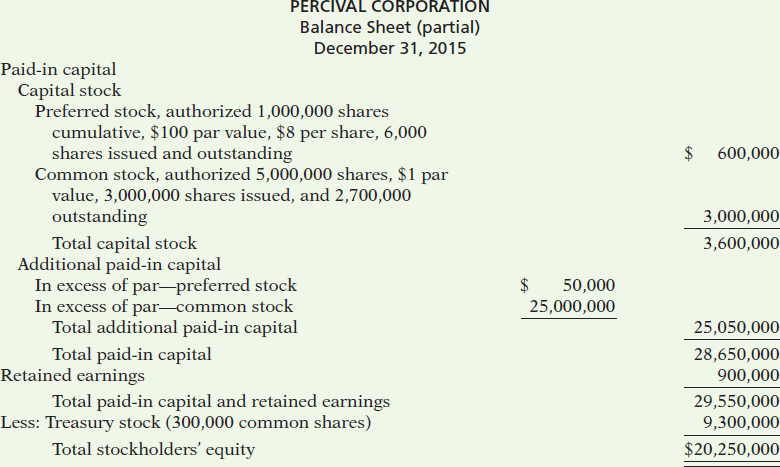
At the meeting, stockholders have raised a number of questions regarding the stockholders' equity section.
With the class divided into groups, answer the following questions as if you were the chief financial officer for Percival Corporation.
(a) “What does the cumulative provision related to the preferred stock mean?”
(b) “I thought the common stock was presently selling at $29.75, but the company has the stock stated at $1 per share. How can that be?”
(c) “Why is the company buying back its common stock? Furthermore, the treasury stock has a debit balance because it is subtracted from stockholders' equity. Why is treasury stock not reported as an asset if it has a debit balance?”
Communication Activity
BYP11-6 Joe Moyer, your uncle, is an inventor who has decided to incorporate. Uncle Joe knows that you are an accounting major at U.N.O. In a recent letter to you, he ends with the question, “I'm filling out a state incorporation application. Can you tell me the difference in the following terms: (1) authorized stock, (2) issued stock, (3) outstanding stock, and (4) preferred stock?”
Instructions
In a brief note, differentiate for Uncle Joe among the four different stock terms. Write the letter to be friendly, yet professional.
Ethics Case

BYP11-7 The R&D division of Piqua Chemical Corp. has just developed a chemical for sterilizing the vicious Brazilian “killer bees” which are invading Mexico and the southern United States. The president of the company is anxious to get the chemical on the market to boost the company's profits. He believes his job is in jeopardy because of decreasing sales and profits. The company has an opportunity to sell this chemical in Central American countries, where the laws are much more relaxed than in the United States.
The director of Piqua's R&D division strongly recommends further testing in the laboratory for side-effects of this chemical on other insects, birds, animals, plants, and even humans. He cautions the president, “We could be sued from all sides if the chemical has tragic side-effects that we didn't even test for in the labs.” The president answers, “We can't wait an additional year for your lab tests. We can avoid losses from such lawsuits by establishing a separate wholly owned corporation to shield Piqua Corp. from such lawsuits. We can't lose any more than our investment in the new corporation, and we'll invest in just the patent covering this chemical. We'll reap the benefits if the chemical works and is safe, and avoid the losses from lawsuits if it's a disaster.” The following week, Piqua creates a new wholly owned corporation called Finlay Inc., sells the chemical patent to it for $10, and watches the spraying begin.
Instructions
(a) Who are the stakeholders in this situation?
(b) Are the president's motives and actions ethical?
(c) Can Piqua shield itself against losses of Finlay Inc.?
All About You
BYP11-8 A high percentage of Americans own stock in corporations. As a shareholder in a corporation, you will receive an annual report. One of the goals of this course is for you to learn how to navigate your way around an annual report.
Instructions
Use Apple's 2011 annual report (see Appendix A) to answer the following questions.
(a) What CPA firm performed the audit of Apple's financial statements?
(b) What was the amount of Apple's earnings per share in 2011?
(c) What were net sales in 2011?
(d) How much cash did Apple spend on capital expenditures in 2011?
(e) Over what life does the company depreciate its buildings?
(f) What were the proceeds from issuance of common stock in 2011?
FASB Codification Activity
BYP11-9 If your school has a subscription to the FASB Codification, go to http://aaahq.org/ascLogin.cfm to log in and prepare responses to the following.
(a) What is the stock dividend?
(b) What is a stock split?
(c) At what percentage point does the issuance of additional shares qualify as a stock dividend, as opposed to a stock split?
Answers to Chapter Questions
Answers to Insight and Accounting Across the Organization Questions
p. 547 A Thousand Millionaires! Q: Why did Mark Zuckerberg, the CEO and founder of Facebook, delay taking his company's shares public through an initial public offering (IPO)? A: Facebook did not need to invest in factories, distribution systems, or even marketing, so it did not need to raise a lot of cash. Also, by delaying the decision to go public, Zuckerberg had more control over the direction of the company. In addition, publicly traded companies face many more financial reporting disclosure requirements.
p. 550 How to Read Stock Quotes Q: For stocks traded on organized exchanges, how are the dollar prices per share established? A: The dollar prices per share are established by the interaction between buyers and sellers of the shares. Q: What factors might influence the price of shares in the marketplace? A: The price of shares is influenced by a company's earnings and dividends as well as by factors beyond a company's control, such as changes in interest rates, labor strikes, scarcity of supplies or resources, and politics. The number of willing buyers and sellers (demand and supply) also plays a part in the price of shares.
p. 553 The Impact of Corporate Social Responsibility Q: Why are CSR-related shareholder proposals increasing? A: The increase in shareholder proposals reflects a growing belief that a company's social and environmental policies correlate strongly with its risk-management strategy and ultimately its financial performance.
p. 558 Why Did Reebok Buy Its Own Stock? Q: What signal might a large stock repurchase send to investors regarding management's belief about the company's growth opportunities? A: When a company has many growth opportunities, it will normally conserve its cash in order to be better able to fund expansion. A large use of cash to buy back stock (and essentially shrink the company) would suggest that management was not optimistic about its growth opportunities.
p. 568 A No-Split Philosophy Q: Why does Warren Buffett usually oppose stock splits? A: Buffett prefers to attract shareholders who will make a long-term commitment to his company, as opposed to traders who will only hold their investment for a short period of time. He believes that a high stock price discourages short-term investment.
Answers to Self-Test Questions
1. c 2. b 3. d 4. c 5. a 6. a 7. d 8. d 9. a 10. c 11. c 12. b 13. c 14. b 15. b $186,000 − (6% × $100 × 10,000) = $126,000 *16 a *17 c
![]() 10
10
Compare the accounting procedures for stockholders' equity under GAAP and IFRS.
 A Look at IFRS
A Look at IFRS
The accounting for transactions related to stockholders' equity, such as issuance of shares and purchase of treasury stock, are similar under both IFRS and GAAP. Major differences relate to terminology used, introduction of items such as revaluation surplus, and presentation of stockholders' equity information.
Key Points
- Under IFRS, the term reserves is used to describe all equity accounts other than those arising from contributed (paid-in) capital. This would include, for example, reserves related to retained earnings, asset revaluations, and fair value differences.
- Many countries have a different mix of investor groups than in the United States. For example, in Germany, financial institutions like banks are not only major creditors of corporations but often are the largest corporate stockholders as well. In the United States, Asia, and the United Kingdom, many companies rely on substantial investment from private investors.
- There are often terminology differences for equity accounts. The following summarizes some of the common differences in terminology.
GAAP IFRS Common stock Share capital—ordinary Stockholders Shareholders Par value Nominal or face value Authorized stock Authorized share capital Preferred stock Share capital—preference Paid-in capital Issued/allocated share capital Paid-in capital in excess of par—common stock Share premium—ordinary Paid-in capital in excess of par—preferred stock Share premium—preference Retained earnings Retained earnings or Retained profits Retained earnings deficit Accumulated losses Accumulated other comprehensive income General reserve and other reserve accounts As an example of how similar transactions use different terminology under IFRS, consider the accounting for the issuance of 1,000 shares of $1 par value common stock for $5 per share. Under IFRS, the entry is as follows.

- The accounting for treasury stock differs somewhat between IFRS and GAAP. (However, many of the differences are beyond the scope of this course.) Like GAAP, IFRS does not allow a company to record gains or losses on purchases of its own shares. One difference worth noting is that, when a company purchases its own shares, IFRS treats it as a reduction of stockholders' equity, but it does not specify which particular stockholders' equity accounts are to be affected. Therefore, it could be shown as an increase to a contra equity account (Treasury Stock) or a decrease to retained earnings or share capital.
- A major difference between IFRS and GAAP relates to the account Revaluation Surplus. Revaluation surplus arises under IFRS because companies are permitted to revalue their property, plant, and equipment to fair value under certain circumstances. This account is part of general reserves under IFRS and is not considered contributed capital.
- IFRS often uses terms such as retained profits or accumulated profit or loss to describe retained earnings. The term retained earnings is also often used.
- The accounting related to prior period adjustment is essentially the same under IFRS and GAAP. IFRS addresses the accounting for errors in IAS 8 (“Accounting Policies, Changes in Accounting Estimates, and Errors”). One area where IFRS and GAAP differ in reporting relates to error corrections in previously issued financial statements. While IFRS requires restatement with some exceptions, GAAP does not permit any exceptions.
- Equity is given various descriptions under IFRS, such as shareholders' equity, owners' equity, capital and reserves, and shareholders' funds.
- The income statement using IFRS is called the statement of comprehensive income. A statement of comprehensive income is presented in a one- or two-statement format. The single-statement approach includes all items of income and expense, as well as each component of other comprehensive income or loss by its individual characteristic. In the two-statement approach, a traditional income statement is prepared. It is then followed by a statement of comprehensive income, which starts with net income or loss and then adds other comprehensive income or loss items. Regardless of which approach is reported, income tax expense is required to be reported.
- The computations related to earnings per share are essentially the same under IFRS and GAAP.
Looking to the Future
The IASB and the FASB are currently working on a project related to financial statement presentation. An important part of this study is to determine whether certain line items, subtotals, and totals should be clearly defined and required to be displayed in the financial statements. For example, it is likely that the statement of stockholders' equity and its presentation will be examined closely.
Both the IASB and FASB are working toward convergence of any remaining differences related to earnings per share computations. This convergence will deal with highly technical changes beyond the scope of this textbook.
IFRS Practice
IFRS Self-Test Questions
- Under IFRS, a purchase by a company of its own shares is recorded by:
(a) an increase in Treasury Stock.
(b) a decrease in contributed capital.
(c) a decrease in share capital.
(d) All of these are acceptable treatments.
- Which of the following is true?
(a) In the United States, the primary corporate stockholders are financial institutions.
(b) Share capital means total assets under IFRS.
(c) The IASB and FASB are presently studying how financial statement information should be presented.
(d) The accounting for treasury stock differs extensively between GAAP and IFRS.
- Under IFRS, the amount of capital received in excess of par value would be credited to:
(a) Retained Earnings.
(b) Contributed Capital.
(c) Share Premium.
(d) Par value is not used under IFRS.
- Which of the following is false?
(a) Under GAAP, companies cannot record gains on transactions involving their own shares.
(b) Under IFRS, companies cannot record gains on transactions involving their own shares.
(c) Under IFRS, the statement of stockholders' equity is a required statement.
(d) Under IFRS, a company records a revaluation surplus when it experiences an increase in the price of its common stock.
- Which of the following does not represent a pair of GAAP/IFRS-comparable terms?
(a) Additional paid-in capital/Share premium.
(b) Treasury stock/Repurchase reserve.
(c) Common stock/Share capital.
(d) Preferred stock/Preference shares.
- The basic accounting for cash dividends and stock dividends:
(a) is different under IFRS versus GAAP.
(b) is the same under IFRS and GAAP.
(c) differs only for the accounting for cash dividends between GAAP and IFRS.
(d) differs only for the accounting for stock dividends between GAAP and IFRS.
- Which item in not considered part of reserves?
(a) Unrealized loss on available-for-sale investments.
(b) Revaluation surplus.
(c) Retained earnings.
(d) Issued shares.
- Under IFRS, a statement of comprehensive income must include:
(a) accounts payable.
(b) retained earnings.
(c) income tax expense.
(d) preference stock.
- Which set of terms can be used to describe total stockholders' equity under IFRS?
(a) Shareholders' equity, capital and reserves, other comprehensive income.
(b) Capital and reserves, shareholders' equity, shareholders' funds.
(c) Capital and reserves, retained earnings, shareholders' equity.
(d) All of the above.
- Earnings per share computations related to IFRS and GAAP:
(a) are essentially similar.
(b) result in an amount referred to as earnings per share.
(c) must deduct preferred (preference) dividends when computing earnings per share.
(d) All of the above.
IFRS Exercises
IFRS11-1 On May 10, Jaurez Corporation issues 1,000 shares of $10 par value ordinary shares for cash at $18 per share. Journalize the issuance of the shares.
IFRS11-2 Meenen Corporation has the following accounts at December 31 (in euros): Share Capital—Ordinary, €10 par, 5,000 shares issued, €50,000; Share Premium—Ordinary €10,000; Retained Earnings €45,000; and Treasury Shares—Ordinary, 500 shares, €11,000. Prepare the equity section of the statement of financial position (balance sheet).
IFRS11-3 Overton Co. had the following transactions during the current period.
| Mar. 2 | Issued 5,000 shares of $1 par value ordinary shares to attorneys in payment of a bill for $30,000 for services provided in helping the company to incorporate. |
| June 12 | Issued 60,000 shares of $1 par value ordinary shares for cash of $375,000. |
| July 11 | Issued 1,000 shares of $100 par value preference shares for cash at $110 per share. |
| Nov. 28 | Purchased 2,000 treasury shares for $80,000. |
Instructions
Journalize the above transactions.
International Financial Reporting Problem: Zetar plc
IFRS11-4 The financial statements of Zetar plc are presented in Appendix F. Instructions for accessing and using the company's complete annual report, including the notes to its financial statements, are also provided in Appendix F.
Instructions
Use the company's annual report to answer the following questions.
(a) Using the information in the statement of changes in equity, prepare the journal entry to record the issuance of ordinary shares during the year ended April 30, 2010.
(b) Examine the equity section of the company's balance sheet. For each item in the equity section, provide the comparable label that would be used under GAAP.
(c) Did the company declare and pay any dividends for the year ended April 30, 2011?
(d) Compute the company's return on ordinary shareholders' equity for the year ended April 30, 2011.
(e) What was Zetar's earnings per share for the year ended April 30, 2011?
Answers to IFRS Self-Test Questions
1. d 2. c 3. c 4. d 5. b 6. b 7. d 8. c 9. b 10. d
![]()
![]()
1A number of companies have eliminated the preemptive right because they believe it makes an unnecessary and cumbersome demand on management. For example, by stockholder approval, IBM has dropped its preemptive right for stockholders.
2Alternatively, the investment banking firm may agree only to enter into a best-efforts contract with the corporation. In such cases, the banker agrees to sell as many shares as possible at a specified price. The corporation bears the risk of unsold stock. Under a best-efforts arrangement, the banking firm is paid a fee or commission for its services.
3Accounting Trends and Techniques—2012 (New York: American Institute of Certified Public Accountants).
4A complete retained earnings statement is shown in Illustration 11-25 on the next page.
*Note: All asterisked Questions, Exercises, and Problems relate to material in the appendices to the chapter.


